Runabout (Star Trek)
Runabouts (" Danube -class " vessels) are a fictional class of small, multi-purpose starships appearing in the Star Trek science-fiction franchise, primarily the television series Star Trek: Deep Space Nine , which aired on syndicated television between 1993 and 1999. They served as a means of transport for the crew of the fictional space station Deep Space Nine , in the early seasons of the series enabling storylines taking place away from the station.

Role in Deep Space Nine
Design and depiction, filming models, computer-generated imagery model, appearances, danube class, yellowstone class (alternate reality), disposability, merchandise, journal articles, external links.
This spacecraft design was created primarily by Herman Zimmerman, Rick Sternbach and Jim Martin in the 1990s for Star Trek: Deep Space Nine , and later used throughout the franchise such as in books, comics, and games. [1]
The idea for the runabout was prompted by the need to provide a way for characters to travel away from Deep Space Nine , allowing the series to feature Star Trek ' s themes of exploration and discovery despite being set on a stationary space station. [ citation needed ] In order to help the new show establish its own identity separate from The Next Generation , the decision was made to have something larger and more capable than the shuttlecraft seen in previous series of Star Trek . [2]
The series bible describes the Danube -class vessels as "the symbol of the Federation presence in [ Deep Space Nine ' s] sector". [3] The Starfleet design elements were intended as a touch of familiarity for the characters (and in turn, the viewers) in environments dominated by alien designs and structures, specifically the Cardassians and Bajorans . [4]
From the third season of DS9 onwards, much of the exploration aspect of the series was facilitated by the starship USS Defiant , which took over much of the runabouts' previous role in allowing characters to move off the station. [5] Defiant was introduced because the producers wanted the series to enable more than two or three characters to travel away from Deep Space Nine at once, while the introduction of the Dominion as an antagonist during the second season created the in-universe requirement for a more powerful and combat-capable starship based at Deep Space Nine . [5]
Overall design of the runabout was supervised by Herman Zimmerman , with Rick Sternbach and Jim Martin responsible for the design work. [1] According to Sternbach, initial designs for the Danube class were based on the 'Spacedock Ferry' that appeared in the film Star Trek VI: The Undiscovered Country . [6]
The Danube -class vessels are larger than shuttlecraft seen in previous series of Star Trek , but significantly smaller than previously depicted starships. The runabouts are usually named after rivers on Earth.
The hull of the Danube -class runabout is shaped roughly like a long, rectangular box. A downward-curving 'wing' is located on each side of the vessel; these start near the top of the hull, and curve down to the warp nacelles . The runabout's impulse drives are located between the wings and the vessel's body. The Deep Space Nine Technical Manual gives the runabout's dimensions as 23.1 metres (76 ft) long, 13.7 metres (45 ft) wide, and 5.4 metres (18 ft) high. [7]
The runabouts have a two-person flight crew, and can carry two other crew. [1] They are fitted with a two-person transporter and accommodation bunks for long missions. [1] [8] According to the first season episode " Dax ", they were capable of speeds up to Warp 5 . Although not explored in the series, background materials indicate the runabout had a modular mission payload system , where the middle section of the runabout could be swapped out for modules carrying different equipment. [1]
The cockpit set was designed by Joseph Hodges, and constructed over a nine-week period. [1] [9] The set was laid out with the two flight crew facing forward and out the windows, while consoles for the two other crew have them facing the sides of the runabout. [10] The runabout's transporter was located in the centre rear of the compartment. [10]
A remodeling of the set occurred between the second and third seasons, with the primary change being new computer consoles around the cockpit. [10] Another major overhaul occurred between seasons four and five, with the transporter bay moved aft behind a large door (which was usually kept open), and a free-standing console added in its place. [10]
The set was redressed on four occasions to serve as the control areas of other vessels: a Maquis raider during " Caretaker ", the pilot episode of Star Trek: Voyager , mirror universe ships in DS9 season three episode " Through the Looking Glass " and season four episode " Shattered Mirror ", and a shuttlecraft from USS Enterprise -E in the film Star Trek: Insurrection . [10]
A set for the runabout's aft living quarters was built for " Timescape ", an episode in the sixth season of The Next Generation (running concurrently with DS9 ' s first season). [9] The set was designed by Richard James, and was funded from The Next Generation ' s budget, in order to take pressure off DS9 ' s finances. [1] [9] Unlike the cockpit construction, design and fabrication of the aft set had to be completed in nine days. [9] This was the only appearance of the Danube class outside of DS9 , and although the set was intended for use on DS9 , it was never used again to depict a runabout's interior. [1] [9]
The filming model was built by Tony Meininger. [1] Filming of the runabout was done by Image G , along with all other miniature effect work for the series. [11]
One runabout, USS Ganges , appeared in season one episode " Past Prologue " with a 'roll-bar' mounted over the top of the ship. [12] This roll-bar, described as containing sensor equipment, was added to the model to help viewers distinguish between Ganges and the runabout USS Yangtzee Kiang during a chase sequence. [12]
Eight subsequent episodes of DS9 show Danube- class ships with roll-bars, including second season episode " The Maquis , Part II", where two runabouts with roll-bars are depicted flying alongside a third, without the roll-bar. [13] A prototype for an updated runabout design, the Yellowstone class, appears in an alternate timeline depicted in the Voyager episode " Non Sequitur ". [13] This episode used stock footage from various DS9 episodes; incongruously, the runabout's destruction depicts the vessel with a roll-bar, while all previous scenes show the vessel without one. [13]
Season six episode " One Little Ship " had a runabout carrying Jadzia Dax ( Terry Farrell ), Julian Bashir ( Alexander Siddig ), and Miles O'Brien ( Colm Meaney ) shrunk down to tiny size, then having to rescue the rest of the cast when Defiant is captured by the Dominion. [14] Screenwriter René Echevarria conceived the 'little ship show' idea as a comedic filler episode early in The Next Generation ' s run, but despite suggesting it multiple times, did not receive the chance to go ahead until late in DS9 ' s run. [15] Meiniger built a new, 6-inch (150 mm) -long runabout model: dialogue in the episode specified that the runabout had shrunk to 4 inches (100 mm) , but a model that small would have had problems with lighting and detail. [16] The model was mounted on a specially built three-axis head, which allowed for easier miniature effect work than with the original filming model. [17]
The first CGI ship ever used in the Star Trek franchise was created by Dennis Blakey and Dorene Haver at VisionArt . It was a 3D computer model of the "Runabout" shuttle for Star Trek: The Next Generation. Previously, Star Trek had exclusively used physical models, which at the time were composited by Adam Howard and Steve Scott at Digital Magic. VisionArt's 3D model of the Runabout was primarily used for the stretching effect when it jumped to warp.
Star Trek: Deep Space Nine season six episode " Change of Heart " later depicted a runabout traversing an asteroid field, then landing on a planet. [18] This was the first episode in which runabout sequences were done completely with computer-generated imagery : complex scenes where the ship weaved through the dense asteroid field were achieved without weeks of miniature effect work, and camera movements during the landing sequence allowed the runabout to be shown from multiple angles in the same scene, as there was no need to conceal a 'mounting point' for the miniature. [18] The CGI model for the Danube class was developed by Digital Muse. [18]
A large number of runabouts are damaged or destroyed over the course of the series. In the third-season episode " Family Business ", Kira Nerys ( Nana Visitor ) quips, "The rate we go through runabouts, it's a good thing the Earth has so many rivers" (referencing the naming tradition of the Danube -class vessels), and in Star Trek 101 , authors Terry Erdmann and Paula Block comment that the series "goes through runabouts like potato chips". [8]
The show's art department joked that any runabout travel should be done on the USS Rio Grande , referring to its distinction as the only Danube -class ship to survive the entire seven-season run of DS9 , and therefore the safest one. It appeared in the series pilot " Emissary ", the final episode " What You Leave Behind ", and eighteen other episodes in between. [37]
In 1993, AMT/Ertl released a 1:72 scale model kit for the runabout USS Rio Grande . [38] During the filming of season two, one of these models was put together by the show's art department for a miniature effect shot where a runabout exploded, instead of having to assemble, then destroy, a more-expensive filming model. [39] Later, the company released a 1:2500 scale model of Deep Space Nine itself, which included three runabouts to place on the station's landing pads. [40] [41]
In 1994, Playmates Toys released a "Runabout Orinoco " playset, in which two of Playmates' 4.5 inches (110 mm) action figures could be seated.
A runabout was amongst the Star Trek Micro Machines produced by Galoob . As well as the standard toy, bronzed and silvered versions have been released in collectors' sets.
Several 'ship' cards from Decipher, Inc. 's Star Trek Customizable Card Game depicted Danube -class ships. A generic Runabout card (based on the appearance in The Next Generation ) was included in the original set, with named runabouts appearing in subsequent sets.
Runabouts appear in several incarnations in the Star Trek Online massively multiplayer online role-playing game. Danube and Yellowstone classes appear as both playable 'small craft' starships and as decorative non-combat pets to be displayed when using larger starships. The Danube -class starship and pet correspond to the DS9 appearance, with the roll bar equipped. However, the Yellowstone runabouts have a different visual design to the ship's appearance in Star Trek: Voyager .
In 2017, CBR ranked the runabout the fifteenth most powerful spacecraft of Star Trek: Deep Space Nine . [42] They note they were an important vessel in the television show early on before the arrival of the USS Defiant spacecraft. [42] They felt they were a big upgrade over smaller shuttlecraft of the period, and while they land the occasionally lucky shot against larger starships, they were no match for them in general. [42]
- 1 2 3 4 5 6 7 8 9 Okuda & Okuda, The Star Trek Encyclopedia , p. 423
- ↑ Reeves-Stevens & Reeves-Stevens, The Making of Star Trek: Deep Space Nine , p. 36
- ↑ Reeves-Stevens & Reeves-Stevens, The Making of Star Trek: Deep Space Nine , p. 83
- ↑ Reeves-Stevens & Reeves-Stevens, The Making of Star Trek: Deep Space Nine , pp.83 & 143
- 1 2 Pierce, New ship to defy constraints on 'DS9 ' , p. C6
- ↑ Reeves-Stevens & Reeves-Stevens, The Making of Star Trek: Deep Space Nine , p. 125
- ↑ Zimmerman, Sternbach, & Drexler, Star Trek: Deep Space Nine: Technical Manual , p. 140
- 1 2 Erdmann & Block, Star Trek 101 , p. 127
- 1 2 3 4 5 Nemeck, Star Trek: The Next Generation Companion , p. 251
- 1 2 3 4 5 Hillebrand & Schneider, Variations of the Runabout interior
- ↑ Reeves-Stevens & Reeves-Stevens, The Making of Star Trek: Deep Space Nine , p. 225
- 1 2 Okuda & Okuda, The Star Trek Encyclopedia , p. 168
- 1 2 3 Hillebrand & Schneider, Runabouts with Rollbars
- ↑ Kaplan, One Little Ship , pp. 39-40
- ↑ Kaplan, One Little Ship , p. 39
- ↑ Kaplan, One Little Ship , pp. 40-1
- ↑ Kaplan, One Little Ship , p. 41
- 1 2 3 Kaplan, Visual Effects , pp. 57-8
- 1 2 . " Past Prologue ". Star Trek: Deep Space Nine .
- ↑ " Q-Less ". Star Trek: Deep Space Nine .
- ↑ " Armageddon Game ". Star Trek: Deep Space Nine .
- 1 2 3 " The Jem'Hadar ". Star Trek: Deep Space Nine .
- ↑ " Our Man Bashir ". Star Trek: Deep Space Nine .
- ↑ " Emissary ". Star Trek: Deep Space Nine .
- ↑ " One Little Ship ". Star Trek: Deep Space Nine .
- ↑ " Change of Heart ". Star Trek: Deep Space Nine .
- ↑ " Valiant ". Star Trek: Deep Space Nine .
- ↑ " Body Parts ". Star Trek: Deep Space Nine .
- ↑ " Battle Lines ". Star Trek: Deep Space Nine .
- ↑ " By Inferno's Light ". Star Trek: Deep Space Nine .
- ↑ " Timescape ". Star Trek: The Next Generation .
- ↑ " The Ship ". Star Trek: Deep Space Nine .
- ↑ " ...Nor the Battle to the Strong ". Star Trek: Deep Space Nine .
- ↑ " Empok Nor ". Star Trek: Deep Space Nine .
- ↑ " Tacking Into the Wind ". Star Trek: Deep Space Nine .
- ↑ Okuda & Okuda, The Star Trek Encyclopedia , p. 412
- ↑ Jackson, Spaceships at the final frontier , pgs. 4, 9
- ↑ Reeves-Stevens & Reeves-Stevens, The Making of Star Trek: Deep Space Nine , p. 236
- ↑ Jackson, Spaceships at the final frontier , p. 43
- ↑ Waugh, Deep Space Nine Model Kit
- 1 2 3 "DS9: The 15 Most Powerful Ships In Star Trek: Deep Space Nine" . CBR . February 18, 2017 . Retrieved July 14, 2019 .
- Star Trek: The Next Generation
- Star Trek: Deep Space Nine
- Star Trek: Voyager
Related Research Articles
Star Trek: Deep Space Nine ( DS9 ) is an American science fiction television series created by Rick Berman and Michael Piller. The fourth series in the Star Trek media franchise, it originally aired in syndication from January 3, 1993, to June 2, 1999, spanning 176 episodes over seven seasons. Set in the 24th century, when Earth is part of a United Federation of Planets, its narrative is centered on the eponymous space station Deep Space Nine , located adjacent to a wormhole connecting Federation territory to the Gamma Quadrant on the far side of the Milky Way galaxy.

The Cardassians are a fictional extraterrestrial species in the American science fiction franchise Star Trek . They were devised in 1991 for the series Star Trek: The Next Generation before being used in the subsequent series Star Trek: Deep Space Nine and Star Trek: Voyager .
In the Star Trek science-fiction franchise, the Maquis are a 24th-century paramilitary organization-terrorist group. The group is introduced in the two-part episode "The Maquis" of the television series Star Trek: Deep Space Nine , building on a plot foundation introduced in the episode "Journey's End" of Star Trek: The Next Generation , and appear in later episodes of those two series as well as Star Trek: Voyager . The Maquis story debuted when three Star Trek television shows running from 1987 to 2001 took place in the same fictional science-fiction universe at the same time in the future. As a result, the Maquis story was told across several episodes in all three shows. The Maquis are especially prominent in Star Trek: Voyager , whose premise is that a Starfleet crew and a Maquis crew are stranded together on the opposite side of the Galaxy.
Enterprise or USS Enterprise is the name of several fictional spacecraft, some of which are the main craft and setting for various television series and films in the Star Trek science fiction franchise. The most notable were Captain James T. Kirk's USS Enterprise (NCC-1701) from the original 1960s television series, and Captain Jean-Luc Picard's USS Enterprise (NCC-1701-D) from Star Trek: The Next Generation .
Starfleet is a fictional organization in the Star Trek media franchise. Within this fictional universe, Starfleet is a uniformed space force maintained by the United Federation of Planets as the principal means for conducting deep space exploration, research, defense, peacekeeping, and diplomacy. While most of Starfleet's members are human and it has been headquartered on Earth, hundreds of other species are also represented. Most of the franchise's protagonists are Starfleet commissioned officers.
In the Star Trek fictional universe, shields refer to a 23rd and 24th century technology that provides starships, space stations, and entire planets with limited protection against damage. They are sometimes referred to as deflectors , deflector shields , or screens . Types of shields include navigational deflectors .

USS Voyager (NCC-74656) is the fictional Intrepid -class starship which is the primary setting of the science fiction television series Star Trek: Voyager . It is commanded by Captain Kathryn Janeway. Voyager was designed by Star Trek: Voyager production designer Richard D. James and illustrator Rick Sternbach. Most of the ship's on-screen appearances are computer-generated imagery (CGI), although models were also sometimes used. The ship's motto, as engraved on its dedication plaque, is a quote from the poem "Locksley Hall" by Alfred, Lord Tennyson: "For I dipt in to the future, far as human eye could see; Saw the vision of the world, and all the wonder that would be."

The Ferengi are a fictional extraterrestrial species in the American science fiction franchise Star Trek . They were devised in 1987 for the series Star Trek: The Next Generation , played a prominent role in the following series Star Trek: Deep Space Nine , and have made brief appearances in subsequent series such as Star Trek: Voyager , Star Trek: Enterprise , Star Trek: Discovery , Star Trek: Lower Decks and Star Trek: Picard .

The USS Defiant is the name of two starships in the Star Trek media franchise, most notably featured in the television series Star Trek: Deep Space Nine (1993–1999) and the film Star Trek: First Contact (1996). Introduced in Deep Space Nine 's third season, it is a warship attached to the show's eponymous space station. The original Defiant is destroyed during the Dominion War in the seventh season and replaced with a largely identical ship.
In the Star Trek franchise, the Klingon Empire makes use of several classes of starships. As the Klingons are portrayed as a warrior culture, driven by the pursuit of honor and glory, the Empire is shown to use warships almost exclusively and even their support ships, such as troop transports and colony ships, are armed for battle. This contrasts with the exploration and research vessels used by Starfleet, the protagonists of the franchise. The first Klingon ship design used in The Original Series , the D7-class battlecruiser, was designed by Matt Jefferies to evoke a shape akin to that of a manta ray, providing a threatening and instantly recognizable form for viewers. The configuration of Jefferies's design featured a bulbous forward hull connected by a long boom to a wing-like main hull with the engine nacelles mounted on each wingtip. Though a variety of Klingon ships have appeared in Star Trek , their design generally conforms to this style. Most Klingon vessels were physically built as scale models, although later computer-generated imagery was used to create the models. In recent years, many of the original studio models have been sold at auctions.

USS Enterprise (NCC-1701-D) , or Enterprise -D , is a starship in the Star Trek media franchise. Under the command of Captain Jean-Luc Picard, it is the main setting of Star Trek: The Next Generation (1987–1994) and the film Star Trek Generations (1994). It has also been depicted in various spinoffs, films, books, and licensed products.
This article discusses the fictional timeline of the Star Trek franchise . The franchise is primarily set in the future, ranging from the mid-22nd century to the late 24th century, with the third season of Star Trek: Discovery jumping forward to the 32nd century. However the franchise has also outlined a fictional future history of Earth prior to this, and, primarily through time travel plots, explored both past and further-future settings.

Enterprise (NX-01) is the fictional spaceship that serves as the primary setting of the American science fiction television series Star Trek: Enterprise . The ship predates the other Starfleet ships named Enterprise and was first seen in the pilot episode "Broken Bow". Its missions included an initial period of deep space exploration and a mission into the Delphic Expanse following the Xindi attack on Earth; it was also instrumental in the formation of the United Federation of Planets with the Vulcans, Andorians and Tellarites.
Shuttlecraft are fictional vehicles in the Star Trek science fiction franchise built for short trips in space, such as between a planetary surface and orbit. Also referred to as shuttles , their introduction preceded the development of the Space Shuttle.
Richard Michael Sternbach is an illustrator who is best known for his space illustrations and his work on the Star Trek television series.
" Message in a Bottle " is the 14th episode of the fourth season of the American science fiction television series Star Trek: Voyager , the 82nd episode overall. It aired on January 21, 1998 on the UPN network.
" Timescape " is the 151st episode of the American science fiction television series Star Trek: The Next Generation , and the 25th episode of the sixth season.
" One Little Ship " is the 138th episode of the television series Star Trek: Deep Space Nine . It is the 14th episode of the sixth season.

Deep Space Nine is a fictional space station, the eponymous primary setting of the American science fiction television series Star Trek: Deep Space Nine which aired from 1993 to 1999. It serves as a base for the exploration of the Gamma Quadrant via the Bajoran wormhole and is a hub of trade and travel for the sector's denizens. It is run by a joint crew of Starfleet and Bajoran officers and it is the home port of a number of Starfleet runabouts, as well as the starship USS Defiant .
The Star Trek franchise features many spacecraft. Various space vessels make up the primary settings of the Star Trek television series, films, and expanded universe; others help advance the franchise's stories. Throughout the franchise's production, spacecraft have been depicted by numerous physical and computer-generated models. Producers worked to balance often tight budgets with the need to depict convincing, futuristic vessels.
- Erdmann, Terry J.; Block, Paula M. (2008). Star Trek 101 . Simon and Schuster. ISBN 978-0-7434-9723-7 .
- Jackson, Rick (2001). Spaceships at the final frontier: building Star trek models . Kalmbach Publishing Co. ISBN 0-89024-317-4 .
- Nemeck, Larry (1995). Star Trek: The Next Generation Companion (2nd ed.). New York: Pocket Books. ISBN 0-671-88340-2 . OCLC 472949117 .
- Okuda, Michael; Okuda, Denise (1999). The Star Trek Encyclopedia: A Reference Guide to the Future . New York: Pocket Books. ISBN 0-671-53609-5 . OCLC 42837231 .
- Reeves-Stevens, Garfield; Reeves-Stevens, Judith (1994). The Making of Star Trek: Deep Space Nine . New York: Pocket Books. ISBN 0-671-87430-6 . OCLC 31508713 .
- Zimmerman, Herman; Sternbach, Rick; Drexler, Doug (1998). Star Trek: Deep Space Nine: Technical Manual . New York: Pocket Books. ISBN 0-671-01563-X . OCLC 40167278 .
- Kaplan, Anna L. (November 1998). "Star Trek Deep Space Nine". Cinefantastique . 30 (9–10): 32–4, 38, 43, 47, 51, 54, 59, 62, 67.
- Kaplan, Anna L. (November 1998). "One Little Ship". Cinefantastique . 30 (9–10): 39–42.
- Kaplan, Anna L. (November 1998). "Visual Effects". Cinefantastique . 30 (9–10): 55–8.
- Waugh, Archie (June–July 1994). "Deep Space Nine Model Kit: Pointers on assembling the AMT/ERTL DS9 space station" . Strange New Worlds (14) . Retrieved April 1, 2011 .
- Hillebrand, Jörg; Schneider, Bernd (October 7, 2010). "Runabouts with Rollbars" . Ex Astris Scientia . Retrieved May 18, 2011 .
- Hillebrand, Jörg; Schneider, Bernd (October 7, 2010). "Variations of the Runabout Interior" . Ex Astris Scientia . Retrieved May 18, 2011 .
- Danube class at Memory Alpha
- Danube class at Memory Beta
- Unnamed Danube class starships
- Runabouts with Rollbars - Webpage identifying the occurrences of the 'roll-bar' across episodes of DS9
- Variations of the Runabout Interior - Web page tracking the changes of the runabout cockpit set over the course of DS9
- Danube Class Runabout at Maquis Forces International - Runabout Graphics/Schematics

Variations of the Runabout Interior
by Jörg Hillebrand and Bernd Schneider
Season 1 Season 2 Season 3 Season 4 Season 5 Season 6 Insurrection Season 7 Summary
The Danube-class runabout first appeared in DS9: "Emissary". Over the years, its cockpit was remodeled several times, most notably between the 4th and the 5th season of DS9. The runabout, including its flight deck set, also appeared in TNG: "Timescape" and in VOY: "Non Sequitur". In addition, the interior was slightly redressed three times to act as Chakotay's ship, as vessels of the Mirror Universe and as the "Insurrection" shuttlecraft.
Our article analyzes the appearances of the runabout cockpit episode by episode. We pinpoint the times when redresses of the set must have taken place or were reverted. While the focus is on the cockpit, we also have a look at the aft section. It was shown prominently only in TNG: "Timescape", but there are also less obvious sightings in DS9.
All variations have in common that they are largely symmetrical, with at most small consoles differing between the port and the starboard side.
The cockpit retains its original look throughout the first season, with only some minor changes until TNG: "Timescape".
Emissary (as Saratoga escape pod)
We can hardly see how far the set extends because of the heavy shaking and because of the many people inside the escape pod. But we can recognize the lateral door and the two pilot seats (pulled closer together) of the familiar runabout set that were used here.

The real runabout interior debuts some time later in "Emissary". We see the lateral doors of the runabout that are opened on the port side at two points in the episode. As we can see, the outer door consists of two sliding wings. While the outer door follows the shape of the hull and is accordingly sloped, the inner door is narrow and possesses an X-shaped structural reinforcement. Looking into the runabout, we can see Dax in front of a yellow illuminated panel, which is embedded in the side wall of the small transporter platform. Everything is symmetrical, so the opposite side wall has the same yellow panel on its outer side. This part of the set will be changed later, hence we call attention to this detail. The inner surfaces of the platform have white illumination, with some sort of grating in front of the lamps. It can be seen only briefly in "Emissary", but it will become clearer in later episodes.

We also get a good impression of the leading end of the cockpit. We can see the windows, the pilot's controls and the rear sides of the chairs, with three tubes between the head rests and the back rests. This will be modified in the course of the series, as well as the consoles in the forward portion of the cockpit. On the very left and very right side beside the chairs we can make out two oblong horizontal black areas. These will change as well. We can still notice in this episode that the two oval side windows are transparent, while they will increasingly often be covered in later appearances of the runabout.
We can see only a bit of the inner side of the inner door, which will be better visible in later episodes. However, the aforementioned X-shaped struts are not yet illuminated here. The red area behind the raised struts seems to have a stripe pattern, which is subject to change just as well.
Finally, we get an impression of the door that leads to the aft section of the runabout. This one is similar to the lateral door and has X-shaped struts as well. It can be found in the middle behind the transporter platform. Behind Dax in her chair, at the port side, we can make out a rectangular black frame on the side wall of the transporter console. This space is still empty. Later in the series a deepening to store phasers and ultimately a small replicator can be found in this place.
Past Prologue
When the runabout appears for the second time, some small changes have already taken place. In this episode there are two different runabouts : O'Brien and Sisko are on the Ganges, Kira and Tahna Los on the Yangtzee Kiang. The only small difference between the interiors of the two vessels can be found in the lighting of the side doors. On the Yangtzee Kiang, the X-shaped reinforcements are not lighted, as its was the case already in "Emissary". On the Ganges the struts are illuminated for the first time. Furthermore, between the two big cockpit windows there is a hidden console that can be moved up. A red button serves to launch the bomb. The console, however, was visible already in "Emissary".

A noticeable difference can be found behind the transporter console. While there used to be a door in "Emissary", both ships in "Past Prologue" have a pentagonal cavity in this place, holding a number of small consoles and printed circuit-like power conduits. Tahna Los uses this access point to install his bomb. Actually, on the two shuttles there are no doors at all that would allow to enter the aft section, not even on either side of the new console! On both runabouts we can also see two new deepenings on either front side of the transporter side wall, holding phasers. In "Emissary" there was just a frame around this area. We can have a good look at the transporter platform itself, including its white illumination on the inside.
The next appearance of the runabout set is in "Babel". Once again we can see the pentagonal cavity in the rear wall and the small phaser shelves, and no door leading aft. On the side wall it can be noticed that the window is still open and that the oblong black bar is dark. But that is already all we can see of the flight deck.
This is an episode in which we can never see the outside of the runabout but only its full-scale interior set. First of all we get a good impression of the interface that is located next to the entrance on the rear wall of the cockpit. It is the same on port and on starboard. It is a standard LCARS interface.

For the first time we can see how someone opens the floor hatch that that is located in front of the transporter platform. The hatch is pentagonal. It appears to be quite heavy and is affixed to the floor with a hinge joint. It flips open rearward. Furthermore, we can see the illuminated X-struts in the side doors as well as the white light inside the transporter platform in this episode. In this episode it does not become evident what is located behind the transporter platform. The phaser cavities are still there, but without the phasers.
When Sisko exits from the runabout we can see across the otherwise dark cockpit that the "X" on the door on the opposite side is accordingly illuminated too. Earlier in the episode, we can watch people that walk directly from the station's hatch into the shuttle. Hence, the complete flight deck set (and not just a door) must have been docked to the docking hatch set.
The Passenger
In "The Passenger" the cockpit shows up just briefly. But we recognize that the sliding door at the rear end is there again. It is the same door that was already present in "Emissary". The phaser storage is empty, the side door has illuminated struts and the dark area on the side of the front consoles is still without light. Also, the window is still uncovered.

Here we can see that the pentagonal cavity at the rear end is back again. The phaser storage is empty, the windows are unbarred and the X-struts are lighted. The yellow illumination of the transporter side walls is still the same too.

However, we are shown for the first time the function of the lateral black bars. They serve to indicate red alert, in a rather obtrusive fashion.
Battle Lines
Nothing was changed about the rear end of the cockpit since the last appearance. We can see the pentagonal cavity again.

More interestingly, we get to see the outer hull of the crashed shuttle (which normally appears in the form of a miniature only). Below the side window there is an emergency exit hatch that Bashir blows off. Furthermore, the warp nacelle that was ripped off is totally wrong and was taken from a Type-6 shuttlecraft.
Doug Drexler: "Yeah, I remember it clearly. We all knew it was wrong. We pointed it out, but the feeling was that it was general texture, and the camera would never see it. Ha,ha!"
The Storyteller
We are shown only a small portion of the cockpit in "The Storyteller". The side door is once again illuminated and the windows are open. We suspect that there is a pentagonal console behind the transporter. Most notably we can recognize that the oblong "red alert" console is not black anymore. It now holds a couple of small LCARS panels, probably to make it look less boring when there is no red alert.

We can see the new lateral LCARS consoles on the port side somewhat better in this episode, as well as the transporter platform and the cavity behind it. Otherwise there is nothing interesting to note.
Dramatis Personae
There is nothing new in this episode, other than that we can see the new LCARS console on the opposite starboard side too. "Dramatis Personae" is the last appearance of the runabout interior in DS9's first season.
TNG: Timescape
Chronologically, the next time we see it is in TNG: "Timescape".
The features that have remained the same since the last appearance include the formerly black bar with the new LCARS interface on both sides, the lighting of the transporter platform, the open windows and the illumination of the X-struts. The phaser storage is empty, but the simple deepening is given more contrast using the famous black tape stripes. It is the first time since "Emissary" that we can have a good look at the forward portion of the cockpit from behind. It seems unchanged, including the red button console from "Past Prologue".

The flight deck now has a central door in its rear portion through which the crew enter the aft section of the runabout. It is overall identical to the one see in "Emissary" and "The Passenger", but does not have the lateral illumination of the preceding episodes. We can see this part of the set with an opened and with a closed door. It is possible to walk to the left and to the right after passing the door; the straight direction is obstructed by a wall. Quite obviously there is no long corridor, as this would have required to attach the new aft section directly to the cockpit set. The new wall appears to be the same that used to be in place of the door in some episodes, but now moved about half a meter rearward.
The door in the aft section of the runabout is identical, only flanked by two fluorescent tubes. Behind the opened door we can see the probably same pentagonal cavity that can be passed by on the left or on the right side, which of course is meant to be on the other side now, facing aft.
As already mentioned, in "Timescape" we see the aft section of the runabout for the first time. As we exit through the rear door of the cockpit, there are sleep compartments on either side. These were later re-used for the interior of the Defiant. Upon entering the aft compartment, there is a replicator on the right side and a computer console on the left side. There are five upright windows at the aft end, which correspond with those on the runabout model. In the middle of the room there is an oblong table and four chairs, the same that will later appear in Voyager's conference room.

Aside from the new compartment, the most important change to the flight deck set is that the former rear wall of the set with the cavity can now be found behind the rear door, which will be like this on the DS9 runabouts as well.
In season 2 the cockpit retains the recessed aft wall behind the door as it appeared in TNG: "Timescape" (at least in most of the episodes).
The Homecoming
The cockpit has its first appearance in this season in "The Homecoming". The first thing to notice is that the small phaser shelf has been replaced by a black console. The lateral door, including the light, is still the same. We can also notice that the rear area of the command section is like in "Timescape", with the pentagonal deepening about half a meter behind the rear door. The large viewscreen on the side of the cockpit has been slightly modified. If we compare its first appearance in season 2 with the last one in season 1, we can see the smaller horizontal field with the white border has been moved from the upper to the lower edge of the interface. The yellow side wall of the platform and the screen beside the door are still the same.

In "The Siege" we only see the docking hatch of the runabout. Unlike in "Emissary" and in "Q-less", not the entire flight deck set was placed beside the station docking set, but just its entrance hatch, with the already well-known deepened wall obstructing the view, although it should not be behind the runabout's entrance. This will be done in several other episodes too.

Cardassians
This episode shows the cockpit set from an unusual perspective, as we can look inside through the open lateral window. There is one recognizable change to the set. So far the triangular boxes above the corner monitors on either side of the pilots' seats were horizontal on the underside. The built-in light aimed straight down. Now the boxes are sloped, with the lights pointing inward.
In "Melora" we can have a good look from the aft at the forward end of the cockpit again. The only change seems to be an addition to the lower console between the two seats. We can see the interface with the movable cover and the red button from "Past Prologue". Beneath the pentagonal console in the familiar wall (now behind the rear door) we can see a new illuminated rectangular area. The side walls of the cockpit are unchanged and the windows are open.

Second Sight (as USS Prometheus interior)
In this episode, the aft compartment set is clearly visible for a second time besides TNG: "Timescape". It was rearranged and now serves as two or three different rooms on the USS Prometheus. The wall with the door leading to the cockpit (now completely red) remains the same as in the TNG episode. The bunk beds on either side and the archway in front of them were removed. A door or gateway was installed on the port side, which is recessed relative to the former bunk beds and makes the set appear somewhat more spacious and less one-dimensional. In the following, "port"/"starboard" and "fore"/"aft" refer to the orientation on the runabout.
We don't see the aft window in the episode, which would have given away that it is the runabout set. In fact, a new wall was inserted instead, including two doors with rounded edges similar to the original one that leads to the front. The difference is that the new doors don't have a double frame. This is an important detail to identify which part of the set we are looking at. There really are two new doors, which we can see only briefly in the third scene the set appears in.
The port and starboard walls with the characteristic zigzag cross-section are still the same as in "Timescape". We only see the windows on the starboard side, which complies with the idea that the set is aboard a starship, as opposed to the narrow runabout. In fact, the starboard side is all windows now, whereas the port side of the set consists of just solid walls with the zigzag shape and a console. This is the same wall portion that was previously located on the starboard side in "Timescape".
The room appears four times in the episode, first as a dining room with a table, then as Sikso's guest quarters, then as Nidell's living room with a couch and a table and finally as some unspecified room. We assume the set was not rebuilt but remained the same throughout the episode, except for slightly rearranged furniture and decoration.
The first time, during the dinner, we can mainly see the starboard side of the set, which is all windows. The solid port side is hardly visible at all, except for the new gateway. We don't see how the guests enter the room, but it is implied that it is through the "old" central door. Seyetik then leaves the set through the "new" aft door on the starboard side when he looks after his wife Nidell. We can see that the new portion is also where the bunk beds are located now, behind the door on both the port and the starboard side. Most likely this is the bedroom of her quarters (although Nidell is said to have prepared the meal).

The second appearance is only brief. Sisko finds Fenna in his quarters when he enters through the "old" door. Once again, we can see the windows on the starboard side.
Right after that, the set appears for the third time, as Nidell's room. The difference is that now the characters (Sisko, Dax, Fenna) use the "new" door on the port side to enter, passing by bunk beds that are located here as well. It almost looks like it is an entirely different set, but we actually just see the other side that the two previous scenes concealed from us. As already mentioned, the solid wall is exactly the same that was also used in "Timescape", but on the other side of the set. Later in this scene, we can also see the windows on the opposite (starboard) side, as well as both new aft doors. Actually, the room could be the very same that earlier appeared as the dining room; even the table is the same. But it would not make much sense for Sisko and Dax to enter through a door that most likely leads to another private room.

When Sisko and Fenna meet for the last time, they are sitting in front of the starboard windows. This may be Sisko's guest quarters yet again. Since the scene consists only of close shots, we can't make out any decoration or furniture that would more clearly establish the location.
The Alternate
Nothing has changed in this episode. We can clearly see the lateral door, still with red stripes and with the illumination of the "X".
Armageddon Game
This is the first time that we can make out a small control interface on the forward starboard side of the transporter console. Otherwise the cockpit remains unchanged. The transporter console is still white on the inside, with a grille in front of the fluorescent tubes. Furthermore, we can see that the door to the aft compartment is shut again, not revealing the wall that should be in the corridor behind it.

The perhaps most significant change, however, is that the windows are barred for the first time. The main reason is that it saves costs in the post production if no stars have to be inserted. The window is covered by simple beige panels of the same color as the walls. The lateral interfaces in the forward portion of the cockpit are unchanged. The X-struts in the door are lighted. The lateral black panels are not permanently illuminated, however.
In "Paradise", the windows are covered with the beige panels too. The replicator, however, has been replaced by a simple flat interface. The rear door is open, with the wall behind it.

In this episode the windows are open again. Otherwise there is nothing special.
Playing God
We can clearly see the front portion of the cockpit, where nothing has changed since "Melora". The windows are barred again with the beige covers. The replicator is there again, on both sides, as it may have been the case already in "Whispers". On the other hand, the two small interfaces at the front side of the transporter are gone. The rear door is closed, the side doors are still the same.

The Maquis, Part I
The doors are open again, revealing the wall with the cavity.
The Maquis, Part II
We can see different runabouts in this episode with slightly different interior arrangements. As we are shown only the lateral front sections of the runabouts, the only visible change is to the windows, however. At the beginning of the episode Sisko, Dukat and O'Brien are flying the Mekong. The windows are open, allowing to look outside.

Later on, Sisko and Dukat take the Rio Grande, whose windows are open as well. Kira and Dax, on the other hand, are on the Orinoco, and Bashir and O'Brien on the Mekong. On the two latter vessels the windows are covered with the beige panel.
This is the first episode to feature the new, more sophisticated looking window cover that doesn't let the windows look like painted over. It appears to consist of two parts and has a reddish basic color (maybe the same as in the doors) with beige borders. At the rear end we can recognize the pentagonal wall console again, but with a significant change. The console is integrated into the rear wall again, hence no access to the aft section is possible. In this episode we can clearly the ceiling of the set as well as the front portion. There are no other changes.

In this episode the wall is moved back again, so that Keiko can stay there and use a replicator that was placed there. The windows are open. The transporter platform is still the same.

The Jem'Hadar
The last time in the second season that we see the runabout is in "The Jem'Hadar".
The aft end is unchanged since "Tribunal". This is another episode with more than one runabout, which differ in their windows but also in the door to the aft section. Sisko, Jake and O'Brien take the Rio Grande to the planet. The door is open and we see the familiar pentagonal console. The windows are open. On the Orinoco with Bashir and Kira the windows are closed with the new cover and the rear door is open. On the Mekong, finally, with Dax and Odo the windows are closed as is the rear door.

The Rio Grande reveals a modification to the lower console between the pilots' seats. Here we can see a terminal holding a couple of isolinear chips. We can see a floor hatch again, but with a different shape than in "Q-less".
Also in this episode, we can see how Jake and Nog enter and exit from the runabout. It seems that, as already in "The Siege", the runabout set was not combined with the station's docking set, which facilitates the production of the episode.
After an appearance in VOY: "Caretaker" the runabout flight deck was significantly remodeled for the first time, prior to the first appearance in the third season of DS9. Many of the consoles were replaced with new, more sophisticated looking ones. The basic floorplan of the set remained the same, but there are a couple of changes that will gradually become apparent in the episodes of season 3.
VOY: Caretaker (as Maquis raider)
The cockpit set was modified to act as the bridge of Chakotay's Maquis raider. The LCARS displays were swapped with 23rd century-style computer controls and supplemented with occasional coffin-shaped structures to separate two consoles. The doors and the wall at the cockpit rear end were given a new, partially ribbed surface, encompassing the transporter platform. In addition, the characteristic oval port and starboard windows were closed and were covered with another computer display. Later in the episode, however, when Chakotay is on the raider again and prepares to ram the Kazon mothership, the windows are open again and we can see the stars.

Overall, the changes look extensive, but they mostly consisted of add-ons that could probably be removed rather easily. Only the front consoles retained their look when the set was turned into the runabout cockpit again.
Heart of Stone
The first time that we see the new runabout interior is in "Heart of Stone". The consoles in the front portion are all renewed with new 24th century LCARS displays, the structure of the section is the new one already seen in "Caretaker". The initially unlighted long black box on either side wall was removed altogether. The new console in its place protrudes less into the cockpit area. The corner above that console with the monitor was replaced with a still larger screen, but one that follows the hull shape and hence appears less boxy. There is some sort of rubber protection strip around the consoles.

We can also notice that the two side doors have been changed. The filling between the beige struts is not striped anymore, but solid red. In addition, two horizontal lamps were installed, which can be seen better in later episodes. The side windows appear to be unchanged. In "Heart of Stone" the rear door is closed. The transporter platform seems to be still unchanged.
We get a better impression of the new interior in this episode. The first thing to notice is the modified inner side wall of the transporter platform, which consists of vertical blue lights strips now. We can see how people are rushing towards the shuttle. The door is opened, and at some distance behind it we can (barely) recognize the familiar pentagonal console again.

We can also have a look at the console area of the runabout. The most noticeable change is that the chairs were modified. The tubes and other attachments were removed, making the seats overall more simplistic. This may have been already the case in "Heart of Stone". In front of O'Brien we can see the new consoles.
The new horizontal lamps can be found above the side doors. The small replicator in the front wall of the transporter platform is still there. In addition, there are two silver handles on either side of the replicator, which are shown more clearly in later episodes.
Through the Looking Glass (as Terran raider)
For this episode the cockpit set was modified for the second time to act as a vessel of a different type. It is the Terran rebel raider, actually the same design as the Bajoran assault vessel. Black stripes were added all over the place, even on the lamp above the side window. The consoles were replaced with a 23rd century design. The window was covered by a new console, and the transporter platform is now hidden behind a console. The ceiling illumination is red here. Interestingly, this is the first time that we see the new outer wall of the transporter platform. The formerly yellow pane was replaced with a greenish blue one that consists of stripes and looks just like the other (inner) wall. The phaser holder is there again, the console in that place is gone. In the place of the replicator we can see a new console, including the Terran emblem.

Improbable Cause
The runabout set had to be reverted to its former state for this episode. We can notice, however, that the two screens at the aft wall of the cockpit were slightly modified. The red door to the aft compartment is closed. The windows are closed as well. We can clearly see the handles on the wall of the transporter platform. The replicator is there again, and is used in the episode. The modified pattern on the inner walls of the platform is visible as well. The side doors are still the same since "Heart of Stone".

The Die is Cast
The only change in this episodes (showing the very same shuttle on the way back from the very same mission) is that the windows are open now.
We can see Nog and Jake in a simulation of the runabout cockpit in Quark's holosuite. The runabout is the same as before. The aft door seems to be open, and we can have a good look at the new consoles with the padded edges.

VOY: Non Sequitur (as Yellowstone class)
The runabout cockpit takes a detour to VOY: "Non Sequitur" before it appears in DS9's season 4. The Yellowstone-class cockpit is the same as that of the latest Danube class from DS9. The windows as well as the rear door appear to be closed. The lighting of the side doors is the same as usual. The transport platform including the handles are the same as well.
Not much happened with the cockpit prior to season 4.
The Visitor
We witness how Jake leaves the station on a runabout. We don't see the cockpit but only Jake looking at the station out of a window. This must be the aft window row in the aft compartment of the vessel.

Hippocratic Oath

As already in "Q-less", O'Brien is working on a hatch in the floor. Its position is still the same, but instead of flipping it open this hatch can be completely removed. The circuitry underneath the hatch has changed as well.
Indiscretion
The next appearance of the cockpit is in "Indiscretion". Here the window is covered again, with the same sheet as in all recent episodes. The difference is that this time the cover is flush with the inner surface of the cockpit and not deepened. Also the recessed part of the cover is now beige like the frame. We can see behind Kira that the door is closed.

Sword of Kahless
The old recessed window cover is back in this episode. The door is initially closed, and when it opens we can recognize the pentagonal console in the wall behind it. Otherwise there is nothing different here.
Our Man Bashir
In this episode nothing has changed either. The aft door is closed. The "columns" that are visible outside right behind the windows in flight direction (port as well as starboard), however, are strange, as nothing like this can possibly be visible outside the vessel. Could it be that this is a part of the set that normally shouldn't be visible?

Sons of Mogh
Here we can see again what the unobstructed view outside the windows should be like. The door is closed. The actual set is unchanged.
The windows and the door are closed in this episode. When Kira and O'Brien leave the shuttle, we can see once more how the wall with the pentagonal console serves to obstruct the view, although it should not be where we see it.

Shattered Mirror (as Peregrine class)
Once again the whole set was redressed for a totally different vessel, this time for a Peregrine-class fighter. The set is overall similar to the one from "Through the Looking Glass", including the excessive black lining and the 23rd century-style consoles. The ceiling lamps, however, are not red here but the "X" on the side doors is lighted red. Once again the windows were covered, with what looks like molten consoles.
The Quickening
The last time that the cockpit appears in its 4th season runabout version is in "The Quickening". The windows are covered, the door is closed. Otherwise everything is as it should be: replicators, LCARS interfaces, handles, illuminated X-struts and the pattern on the transporter platform.

For season 5 the cockpit was once again extensively rebuilt, for the first time since season 3. This time especially the rear portion of the set was modified, whereas the area around the seats and consoles remained untouched.
The first time that these changes appear is in DS9: "The Ship", but the scenes are so blurry that we don't see too much of them.
Nor the Battle to the Strong
This is the first time that we can clearly see the modifications.
The transporter platform was moved from the front section of the cockpit to the area behind the rear door. The door was widened and is (at least in this episode) permanently open. The two monitors that are located on either side of the door in the rear wall were modified as well. The right one now displays a view of the runabout, while the left one has a new LCARS interface. In the former place of the transporter console there is a new separate console, that allows to pass on the left or the right (easier than with the transporter in that place). On either side of the transporter platform there are narrow doors that allow access to the aft compartment. The transporter platform is open only on the front side, the rear panel is illuminated. The LCARS panels on the transporter and the two replicators still exist, only the handles were removed. From now, the cockpit windows are mostly barred.

Without further modifications we can see this new cockpit in "The Assignment", "Let He Who Is Without Sin", "Things Past", "The Ascent", "The Darkness and the Light", "In Purgatory's Shadow", "By Inferno's Light", "Blaze of Glory" and "Empok Nor". In all these episodes the windows are covered and the door is open.
Something of interest in this episode is the new rectangular hatch in the cockpit floor behind which the Orion Syndicate's bomb is hidden.

The Darkness and the Light
We can see for the first time that on the side walls behind the new big opening at the aft end, there are large LCARS panels. These look different in almost each episode.
In Purgatory's Shadow
There is a problem with the way that Garak enters the ship. We can see how he is standing in front of the docking hatch, how the outer door of the runabout slides to the side and reveals the usual pentagonal console that shouldn't be there. Garak steps in, but from the inside we can see him come in through one of the doors beside the transporter platform, not through the side door behind the window. There is no other door on that side of the hull. The goof may have been more or less deliberate, as it was required to let Garak enter the cockpit slowly enough to notice only after a few seconds that someone is already sitting there.

Blaze of Glory
We see how Sisko is working in a Jefferies tube in the aft section of the ship. We have to wonder where the space is for a full-scale Jefferies tube though. When the door opens there is the usual pentagonal console in the background, simply to obstruct the view.

Here the crew enters the normal way through the side door again. In the background the docking tube is visible. The episode also shows the area between the rear door and the transporter.

Nothing exciting happens with the cockpit in season 6. The windows are always barred. The big red door is mostly open, except for "Valiant".
One Little Ship
This is the first time that we can see the cover on the runabout's windshield.

Change of Heart
This is the first episode where we can see how the big door to the aft section slides open.

There is also a blooper in this episode, albeit not a very obvious one. When Jake's and Nog's runabout is being pursued by the Jem'Hadar, the two are shown head on, from the area of the windshield. The window pane including the central strut, which is normally located just forward of the trapezoid panel, has been removed for this take. Otherwise the latter would have obstructed the view. We can still see the contours of the junction with makeshift paint.
Star Trek: Insurrection
Star trek: insurrection (as enterprise-e shuttle).
The summer break between the 6th and the 7th season gave the set builders the opportunity to redress the cockpit rather extensively for the streamlined Enterprise-E shuttle in "Star Trek Insurrection".
The window frames were removed and replaced with different ones matching the outside view of the shuttle. The two side windows were covered with consoles. The wall is continuous where the big door opening used to be on the runabout. A transporter platform is now located here. There are still LCARS displays on the left and on the right, but with different graphics. The consoles underneath the front windows are similar as those of the runabout though. Overall, the new cockpit was given much darker, earthy colors. The chairs are still the same.

For this season the cockpit was reconstructed and repainted to its previous appearance. The front end is the same again as already in season 5. The windows are always closed in season 7. There are once again different LCARS panels on the two side walls behind the big central door.
Treachery, Faith and the Great River
Here we can see for the second time (since "Valiant") how the large door at the rear end opens and closes.
A ventilation opening was added to the central wall to allow Laas to flow into the ship. This opening, however, hardly makes sense in this place, as the wall is very thin here and the retracted door is right behind the grille.

Prodigal Daughter
In this episode the pentagonal console makes another appearance behind the runabout's entrance hatch.

What You Leave Behind
This is the last appearance of the runabout, and we can also see the out of place pentagonal wall behind the entrance hatch for a last time.
The following images illustrate the basic configuration of the runabout before and since season 5, when the transporter was moved behind the rear door.
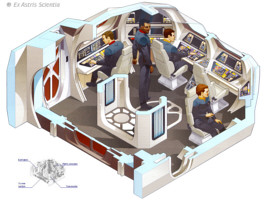
Here is an annotated list of all appearances of the runabout set:
Re-Used Shuttle Interiors - runabout interiors, other shuttle cockpits
Redresses of the Type-9 Shuttle Cockpit - its various re-uses for Starfleet and alien shuttles
Redresses of TNG's Alien Shuttle Cockpit - history of the cockpit set that appeared in many TNG episodes
Galleries - Starfleet Bridge Illustrations
Thanks to Alex, who spotted the goof in "Valiant", and to DataCable, who found the new light arrangement in "Cardassians". Thanks also to Svetz Falhain for the hint about the appearance of the aft section in "Second Sight" and to Richard Compton for pointing out the use of the set for the Saratoga escape pod.

https://www.ex-astris-scientia.org/inconsistencies/runabout_interior.htm
Last modified: 28 Jan 2024

© Ex Astris Scientia 1998-2024, Legal Terms
This website is not endorsed, sponsored or affiliated with CBS Studios Inc. or the Star Trek franchise.
Fleet Yards
Memory Beta, non-canon Star Trek Wiki
A friendly reminder regarding spoilers ! At present the expanded Trek universe is in a period of major upheaval with the continuations of Discovery and Prodigy , the advent of new eras in gaming with the Star Trek Adventures RPG , Star Trek: Infinite and Star Trek Online , as well as other post-57th Anniversary publications such as the ongoing IDW Star Trek comic and spin-off Star Trek: Defiant . Therefore, please be courteous to other users who may not be aware of current developments by using the {{ spoiler }}, {{ spoilers }} OR {{ majorspoiler }} tags when adding new information from sources less than six months old (even if it is minor info). Also, please do not include details in the summary bar when editing pages and do not anticipate making additions relating to sources not yet in release. THANK YOU
- Memory Beta articles sourced from video games
- Memory Beta articles sourced from games
- Memory Beta articles sourced from Star Trek Online
- Starship classifications
- Small craft classes
- View history
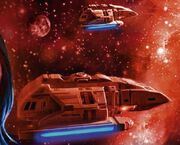
Danube -class runabouts.
A runabout was a small warp-capable vessel, similar to a shuttlecraft , but providing for more interior space and crew amenities for extended interstellar trips.
- 1.1 Alternate timelines
- 2.1 Federation Starfleet
- 2.2 Cardassian
- 2.3 Romulan
- 2.4 Terran Empire
- 3 Runabouts of unknown class
- 4.1 Connections
- 4.2 External link
History [ ]
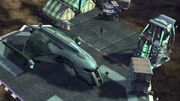
A Romulan Kestrel -class in 2409 .
The Hubble VXT was a type of runabout in Starfleet service in the mid- 23rd century . ( TOS novel : Final Frontier )
The Federation Starfleet Danube -class of starships were referred to as runabouts. ( DS9 episode : " Hippocratic Oath ")
A type of runabout was assigned to the USS Voyager . ( VOY novel : Cybersong )
The Cardassians also operated runabouts, such as the defense runabout . ( DS9 novelization : The Way of the Warrior )
By 2409 , the Romulans had their own model of runabout, the Kestrel -class . ( ST video game : Star Trek Online )
Alternate timelines [ ]
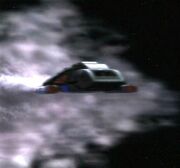
The USS Yellowstone in 2372 .
In an alternate timeline, in 2372 , Starfleet developed the Yellowstone -class runabout, which had a very similar design to the Danube -class. The Yellowstone -class featured tetryon plasma warp nacelles . ( VOY episode : " Non Sequitur ")
In the Kelvin timeline created by Nero and Spock , Starfleet used runabouts in the 2250s decade . ( ST - Starfleet Academy novel : The Gemini Agent )
In the mirror universe , the reborn Terran Empire deployed Danube -class runabouts, such as the ISS Runabout , in the year 2409 . ( STO - Cardassian Struggle mission : " Crack in the Mirror ")
Runabout classes [ ]

2370s Danube -class runabout .

Federation Starfleet [ ]
- Danube -class
- Yellowstone -class
Cardassian [ ]
- defense runabout
Romulan [ ]
- Kestrel -class
Terran Empire [ ]
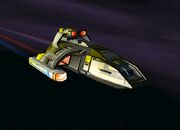
The ISS Runabout in 2409 .
Runabouts of unknown class [ ]
- USS Colorado
- USS Dordogne
- USS Hippocrates
- USS Madeira
Appendices [ ]
Connections [ ].
- See also : Crawlabout • Liaison cutter • Warpshuttle
External link [ ]
- Runabout article at Memory Alpha , the wiki for canon Star Trek .
- 1 The Chase
- 2 Preserver (race)
- 3 Totality (Andromeda)
Star Trek: 10 Secrets Of The Danube-class Runabout
9. orinoco flow.

Early scripts for Star Trek: Deep Space Nine referred to the three runabouts docked at the station as "Runabout-class" vessels. However, this designation was never spoken on screen and Michael and Denise Okuda's 1994 first edition Star Trek Encyclopedia referred to them as "Danube-class" runabouts – a term which eventually found its way into the series during the fourth season episode "Hippocratic Oath".
Of course, the Danube-class designation refers to the second-longest river in Europe, the Danube River, and (just speculating here) possibly Johann Strauss' "The Blue Danube", famously used in 2001: A Space Odyssey and long a go-to source for Star Trek easter eggs.
Individual runabouts were also named for rivers, each given a "USS" prefix and unique "NCC" registry, indicating that runabouts are their own individual starships and not simply shuttlecraft attached to larger motherships. Named runabouts appearing in Star Trek: Deep Space Nine included the USS Gander, USS Ganges, USS Mekong, USS Orinoco, USS Rio Grande, USS Rubicon, USS Shenandoah, USS Volga, USS Yangtzee Kiang, and the USS Yukon.
While Star Trek's producers generally preferred not to use exclusively Earth-centric names and references (generally following the rule that if there are three proper names, two can be from Earth but one must be alien), each of these ships was named for a river found on Earth.
According to DS9 co-creator Michael Piller, the writers had hoped to name runabouts after alien rivers too, but found it difficult to incorporate these names into scripts without unnecessary tangents to explain where they came from.
I played Shipyard Bar Patron (Uncredited) in Star Trek (2009).
Runabouts occupy a range of usefulness between a shuttle and a small starship. Generally modular in nature, they are built with the "go anywhere, do anything" school of thought, which makes them useful for low-intensity missions independent of their base or mothership. With greater defenses, range, and accommodations, these craft are suited for missions of over a week and can be outfitted for even longer missions when necessary. They are more commonly found aboard starbases, though most starships can handle at least one in their hangers. These are the most capable auxiliary craft in Starfleet.
- 1 Danube -class runabout
- 2 Arrow -class runabout
- 3 Volga -class runabout
- 4 Orion -class runabout
- 5 Delta -class runabout
- 6 New Atlantic -class runabout
- 7 Executive type runabout
Danube -class runabout
The Danube -class runabout was designed in the mid-2360s to serve as a standardized utility vehicle across the Federation , capable of low-intensity tasks across multiple mission parameters, ranging from cargo transport to passenger service to scientific missions to medevac. With a standardized cockpit module and warp sled, multiple modules could be used with this class of vessel to do things that simple shuttles could not and that a full starship would be a waste for. This class was intended mainly for starbases though was also assigned to large starships. It remains one of the most common medium-sized craft in service, over thirty years later, because of its utility and survivability.
This class of runabout has a cockpit module that has a standard exterior with two interior variations: the primary differences being that the later module has a free-standing console in the center of the cockpit, while the transporter has been pushed back to its own compartment, rather than being in the cockpit itself. Both modules continue to be produced, though the variation with the free-standing console is more common now. Aft of this, modules can be installed in many different configurations, the most common being a corridor module with four quarter-sized modules connected to it. A single large module, two half modules, and many other combinations can also be achieved. These modules are quick to build and install and have a wide variety of purposes. There is a standardized aft module with a crew rest area, lounge, and replicator, but this can also be customized or omitted when there is a large module that takes up the entirety of the craft aft of the cockpit. Additional roll-bar modules such as torpedo launchers or sensor arrays can be added above the vessel as well.
Armaments are comprehensive, with all-around coverage of phaser arrays and two microtorpedo launchers, and its tactical utility can be increased further with specialized modules that can make it into a formidable patrol vessel.

Arrow -class runabout
Developed in the late 2380s, the Arrow class runabout is a much larger craft than the Danube class runabout, at around twice its length. It is intended for longer duration missions and can support larger crews. Unlike its smaller cousin, it is less modular; interior spaces can be reconfigured for mission needs, but it is more complicated than simply swapping different modules, so typically these vessels remain in a single configuration for extended periods of time.
These vessels are sleek and angular, with large wings to increase their performance in atmospheric flight. They have several phaser arrays and torpedo launchers, which make them capable patrol ships. The forward cockpit can seat up to nine and there are additional stations and a four-place transporter aft. A crew rest area is located amidships with views out into space, along with compartments that can be configured as bunk rooms or labs. Further aft are other mission configurable spaces and a relatively large cargo hold. Access to the lower deck is provided from ladders amidships as well as ramps leading down from the cockpit's side exits, and this level contains two hatches compatible with most standard docking ports, as well as additional equipment storage. Primary egress and ingress is provided by a forward ramp that lowers from the floor of the sub level.
Configurations of this vessel include as a patrol craft, as a scout, as a small research vessel, as a passenger transport, and as a general utility vessel. They are too large to be used aboard most starships, but they are common at starbases.
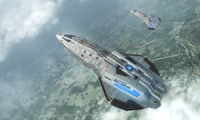
Volga -class runabout
The Volga represents the Federation's best effort at a compromise between the need to provide smaller Starfleet vessels with long-legged runabout support and the limited hangar space which is usually available on such ships. Smaller than many contemporary shuttle designs, the Volga is rated as a runabout due to the remarkable range enabled by her highly efficient warp core and the extensive instrumentation and advanced tactical systems adapted from the Delta Flyer project. While the development of more powerful and capable runabouts has been a boon to Starfleet since their inception in the early 2370's, the large size and extensive maintenance requirements of these high-performance craft have been a persistent barrier to their deployment on small starships or Starfleet installations which would benefit the most strongly from their enhanced capabilities.
The Volga has a relatively large forward cockpit which is similar to a type-11 shuttle , but the forward stations are split. Aft of the cockpit is a two person transporter as well as a crew rest area, followed by a small cargo bay. It is substantially faster than shuttles and has deployable airfoils for enhanced atmospheric performance. These airfoils also have wingtip phaser arrays. This craft operates with a standard crew of six, but can also be configured to carry up to twenty people on shorter missions. It is less modular than other runabouts, as there is much less space available for specialized equipment, but it makes a very capable general support craft for small starships. Entry is provided primarily by a large aft ramp, but there is also a docking port on the top of the craft. Unlike most Federation small craft, the Volga is equipped with landing struts that deploy to allow for appropriate ground clearance when the vessel is on the surface.
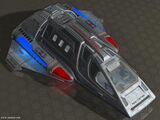
Orion -class runabout
Designed originally as a faster, more heavily-armed version of the Danube class runabout (a project that would eventually become the Arrow class runabout), the Orion class project was tailored in the last few months before the Dominion War broke out as a high-speed scout vessel, that vastly outperformed all other small vessels, with an astonishingly-fast warp drive that could top Warp 8 on a regular basis. This vessel was designed to be able to linger in or near enemy space with a small profile and powerful sensor arrays that would be equally as useful for peacetime applications. During its wartime service, it proved especially popular with Starfleet Intelligence, for its ability to get in and out quickly before it could be detected, even without a cloaking device. However, because of this advanced warp drive system, it's systems are consider rather high maintenance and it spends a lot of its life in the hanger. Post-war, this craft has seen service on frontline outposts and starships, enabling explorers to increase their effective range and dramatically improving the effectiveness of patrol vessels.
This vessel is built for the primary mission of scouting, but it can also be used as a high-speed courier for small, sensitive packages or important individuals. It has a normal crew of three, a pilot, a commanding officer, and a mission specialist, but can accommodate a fourth person if necessary. The Orion can support missions of up to several weeks, with two crew cabins and a mess area, along with a transporter, replicator, and medical supplies. Most of these vessels have been refit with EMH programs as their duties call for them to frequently be out of contact with Starfleet. Access to the vessel is provided by dorsal and ventral hatches, along with a larger hatch on the stern of the craft that is also equipped with an airlock for EVA situations. Tactical systems are relatively light, as the vessel is designed to flee rather than fight, but it does have a forward phaser bank and two aft banks.
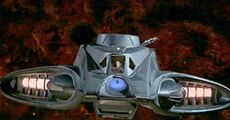
Delta -class runabout
The Delta class was created from the efforts of the crew of the USS Voyager to establish a new, formidable and multi-purpose small craft that could perform tasks well above and beyond that of the Intrepid class' standard Type 9 shuttlecraft . The Type 9 shuttles suffered from being cramped, short-ranged and limited in capabilities, which hampered Voyager' s efforts to get home from their estimated 70+ year journey through the Delta Quadrant .
The first of the class, the Delta Flyer, was originally constructed by Lieutenant Commander Tuvok, Lieutenant Tom Paris, Lieutenant B'Elanna Torres, Ensign Harry Kim and Seven of Nine. The Delta Flyer's original mission and reason for construction was to retrieve a multispatial probe from a gas giant, and therefore was outfitted with tetraburnium hull plating which would help it survive the massive amounts of pressure. However, while constructing the Delta Flyer it was decided that the crew would outfit the ship with all the latest and most potent technologies in order to make it a multipurpose vessel to suit all their needs. Eventually Borg-enhanced regenerative shielding, bio-neural gel pack circuitry, retractable warp nacelles, more "pilot-friendly" controls for better control handling, upgraded warp systems and a phaser array system were all installed during the construction of the vessel.
When Voyager returned to the Alpha Quadrant, the Starfleet Corps of Engineers immediately began to implement the design with a few upgrades to the Starfleet systems that Voyager didn't have during the ship's construction. Although somewhat resource-intensive for a runabout, it paid itself off two-fold in its usefulness and abilities. These vessels are highly advanced but they take up a lot of hanger space. Like the more ubiquitous Volga class, they're less modular than the Danube.
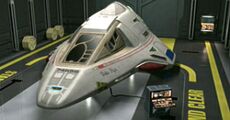
New Atlantic -class runabout
Designed to be the true successor to the modular and highly-useful Danube class runabout, the New Atlantic class runabout is the closest upgrade in terms of size, capabilities, and modularity to her older sister. This class was developed with lessons learned from some of the other runabout classes developed after the Danube but is generally an evolutionary design rather than a revolutionary design; while it uses some novel components, such as annular warp coils, most of her systems are tried-and-true. It is especially popular for long-range missions, as its modules allow it to be equipped with additional fuel and comfortable living quarters.
The ship is slightly longer and taller than the Danube-class, with a cockpit in the nose of the craft on the upper level, followed by crew rest areas, additional crew stations, and small cabins for four. The lower module is especially large and essentially can change this vessel's entire configuration with a single overhaul stop. Configurations for these modules range from passenger modules, to command-and-control modules, to VIP accomodations, to scouting and scientific modules, to tactical modules. In addition, this class has additional mounting points for two modules on the top of the hull, which range from torpedo launchers to phaser cannons, which can turn this ship into a capable gunship for patrols.
In the center of each warp engine are two extendable cylindrical modules which hold two of the craft's phaser arrays, which can rotate to optimize firing solutions. There are also two fixed arrays on the top of the ship.
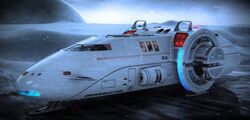
Executive type runabout
The Executive type runabout was classified as a shuttle until the category of runabouts was introduced in the mid-24th century. This class of vessel is used to transport dignitaries and senior officers from ground to orbit in relative comfort. It is also capable of intra-system flights and is relatively common in the core worlds. Unlike purpose-built runabouts, however, they aren't capable of long-distance journeys.
Entry is provided through two side hatches, which also separate the cockpit from the seating area. It has a single large impulse engine on the stern and is equipped with standard navigational shielding, but no weapons.
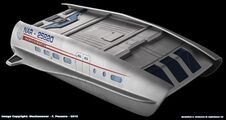
- Specifications
- Federation Small Craft Classes
- Federation Small Craft
- Auxiliary Craft
- View history
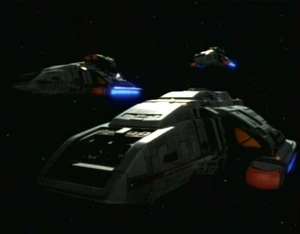
A trio of Danube -class runabouts in 2370 .
A runabout was a spacecraft type introduced by Starfleet in the late 2360s . Runabouts were warp -capable vessels between a shuttle and a starship in size, and capable of being operated by one crew member, although two or more was preferred. They featured expanded cargo and passenger capability over shuttles .
Runabouts were armed well enough to defend themselves against similarly sized attackers and for use in customs enforcement, but were no match for full-size warships under most circumstances. They were typically assigned to space stations or starships as auxiliary craft.
The Cardassian Union copied the design and produced their own version in the early 2370s .
Starfleet normally named runabouts after rivers on Federation planets .
Danube Class Runabout Names: [ ]
Known classes of runabout [ ].
- Danube -class
- Yellowstone -class
- Flar -class
External links [ ]
- Runabout article at Memory Alpha , the canon Star Trek wiki.
- Runabout article at Memory Beta , the non-canon Star Trek wiki.
- Runabout article at Star Trek Expanded Universe .
- 1 Invincible class
- 2 William V of the United Kingdom
- 3 Task Force Invincible (Vanguard)
- The Original Series
- The Animated Series
- The Next Generation
- Deep Space Nine
- Strange New Worlds
- Lower Decks
- Star Trek Movies
- TrekCore on Twitter
- TrekCore on Facebook

All review photos courtesy of IronCaniac.
Ever since I was a kid and saw the first LEGO space themed set, I hoped that there eventually would be a Star Trek theme. Alas, despite LEGO adding licensed sets from many pop culture franchises like Marvel, Disney, and Jurassic World over the years, there was never a Star Trek set. That all finally changed when began selling officially licensed Star Trek sets – and as I’m partial to minifig scale vehicles, the first set I chose to get was their 493-piece Class F shuttlecraft.
It’s been a few years since I’ve built a brick set, but I was able to finish this shuttle in just under three hours. Even though these weren’t LEGOs, the build experience was completely indistinguishable from building with LEGO bricks. The pieces fit together just like LEGOs do, likely because LEGO’s patents have expired and now other companies can make brick pieces exactly to LEGO’s specs.
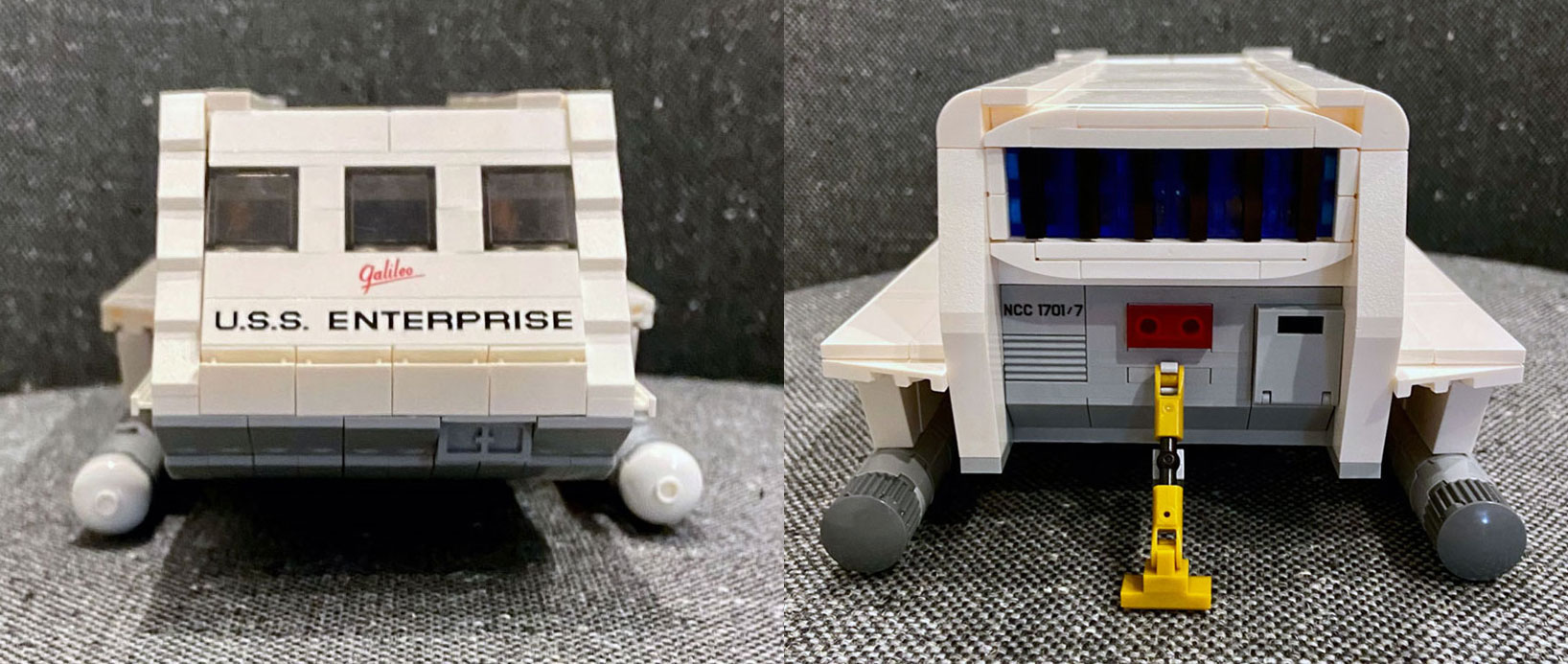
What impresses me the most is just how closely the brick model resembles the onscreen Galileo shuttle from the Original Series. It’s a good thing that shuttle was so blocky in appearance, but it’s also a testament to BlueBrixx’s attention to detail in what they chose to re-create in brick form. The pieces fit together very tightly, making this model very sturdy… except for its nacelles.
The nacelles are the only weak point in the model. As in, literally, they’re a weak point — the front third of the nacelles have a tendency to disconnect if you accidentally put downward pressure on the model’s bow; this is because the shuttle model actually rests its full weight on the nacelles.
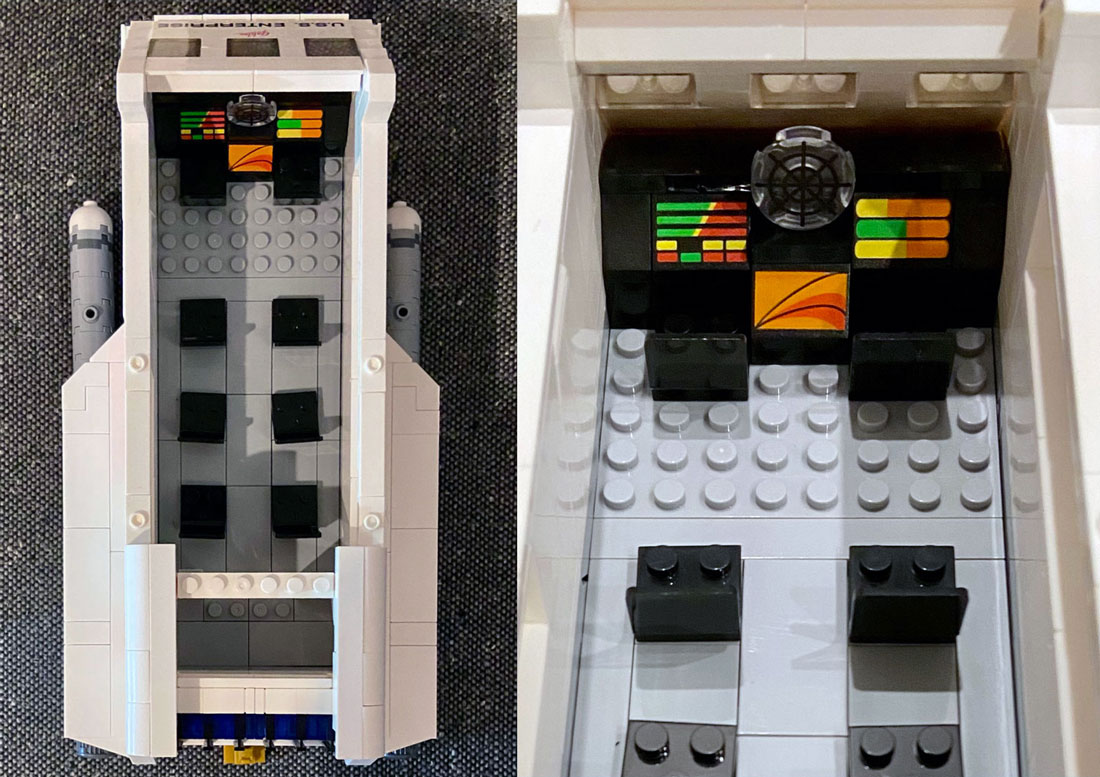
Without anything to support the shuttle’s front half, the nacelles’ front sections bear a lot of strain at the segments that contact the surface. This minor shortcoming doesn’t detract from the model at all, though, because the nacelles hold together surprisingly well, all things considered — as long as you’re careful about where you’re putting pressure. You could also solve the problem by placing something like an extra brick or a small display stand underneath the forward bow to support it.
Being in minifig scale, the model naturally has an interior that can accommodate them. There are no minifigs included with the set, but as with the onscreen shuttle, there are seats for up to 8 figures – plus some standing room behind the helm too. Interestingly, the Memory Alpha entry for the Class F shuttle is officially listed as having a crew complement of only 7, so perhaps the extra seat is intended to be for one of the pilots when then they need a break!

The interior is every bit as detailed as the exterior and accurately replicates what was seen onscreen to the extent that is possible in small plastic bricks. There is also an aft compartment that I don’t believe was ever seen onscreen (and is not accessible from the main compartment unless you remove the door).
That could present an opportunity for creativity: customizing the space using other bricks, which I look forward to trying at some point.
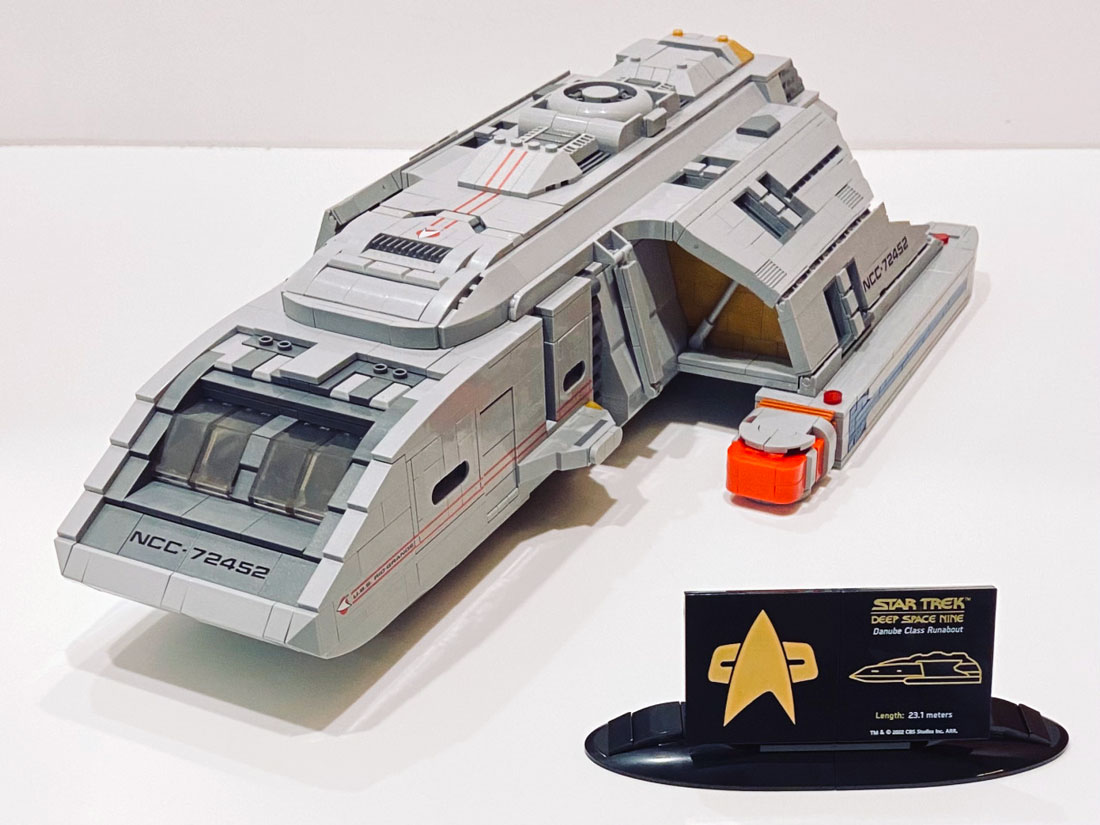
The USS Rio Grande was one of the three original Danube -class runabouts assigned to Deep Space 9. It was the only runabout of the original trio to survive the full run of the Star Trek: Deep Space Nine series. Over the course of the series, the Rio Grande discovered the Bajoran wormhole, crossed over into the Mirror Universe, and even singlehandedly destroyed a Jem’Hadar attack ship.
A vessel with such an illustrious career deserves a tremendous tribute, and BlueBrixx fittingly has made sure that its 3090-piece Rio Grande model lives up to the distinguished runabout.
As with the Galileo shuttle, the most striking initial impression is just how closely this brick-built model resembles the onscreen Rio Grande , both in its exterior and interior. BlueBrixx has recreated just about everything that was depicted onscreen, even the rear sleeping and dining compartment — complete with a replicator! – that wasn’t even seen in Deep Space Nine , but in TNG’s “Timescape.”
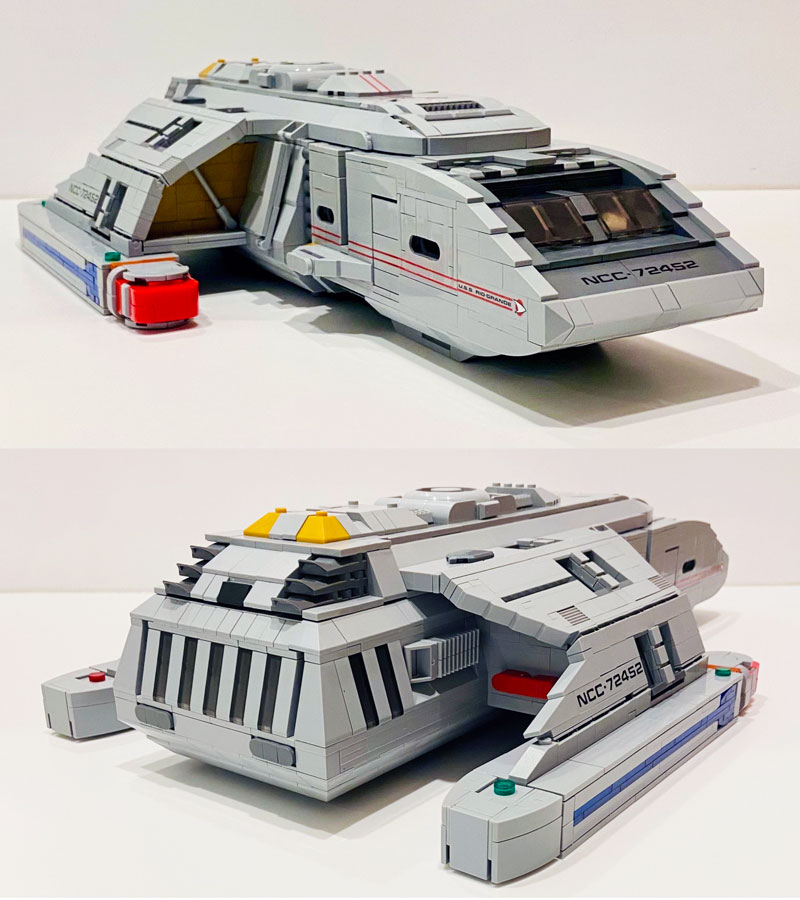
Most impressively, the designers have also included things that were never seen onscreen, such as the specialized mission modules in the midsection and engine components in the pylons.
The build experience on this one is best described as similar to running a marathon; proper planning and pacing is a must. The runabout may look sleek and compact when finished, but this massive set is a beast, and more than likely will take you at least a few days to complete.
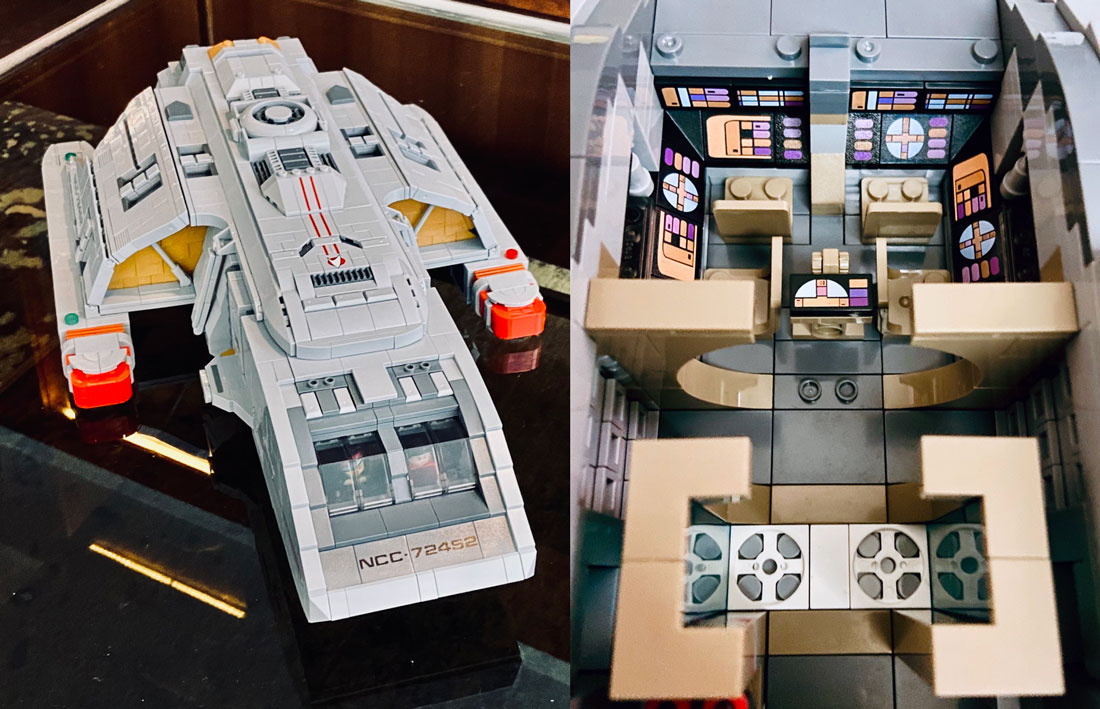
I wouldn’t consider it a set for beginners, and it’s definitely not a set for kids. The build is still a very rewarding experience, especially when you finally snap on the top cover and start to hear the DS9 theme play in your mind. (Well, maybe that’s just me!)
As the BlueBrixx product page shows, the set includes a rollbar that was seen on some runabouts, most notably in “The Jem’Hadar.” I’ve opted not to include this rollbar on my model, because the Rio Grande was only equipped with this module in just one out of its 40 appearances.
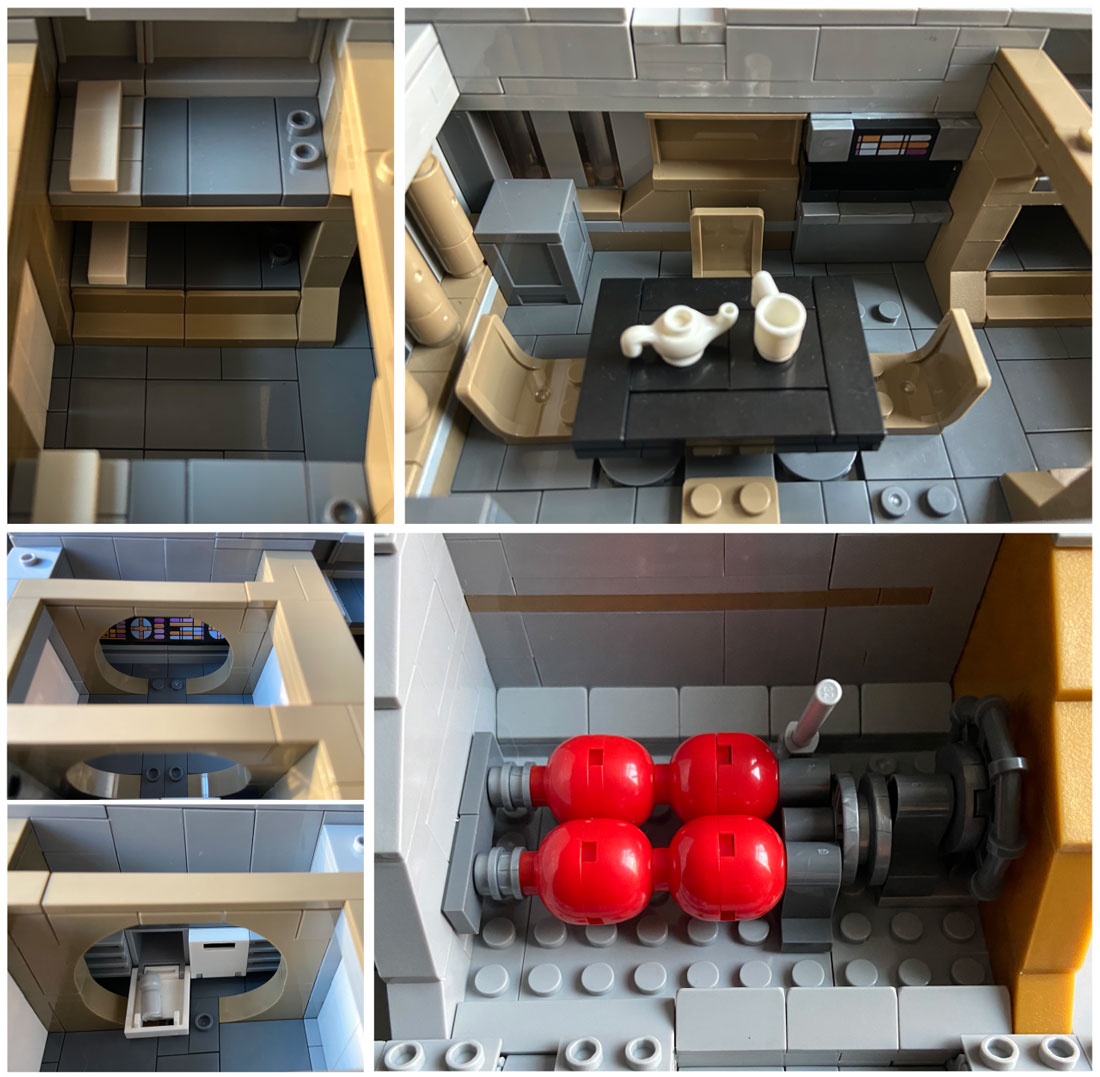
One of the great things for me about brick sets is that you can inject your own creativity as you build. For example, I wasn’t crazy about building the toilet that BlueBrixx included in the instructions, so I used some spare LEGO bricks and custom minifig accessories to create an armory in its place. I think the armory turned out pretty well, and the LEGO bricks fit seamlessly in case anyone was wondering about compatibility.
Now that I’ve built multiple BlueBrixx Star Trek sets, it’s becoming increasingly evident to me is that these kits are clearly a labor of love, developed by devoted Star Trek fans. I’ve noticed many places where the designers could’ve opted for a simpler build but went with a more complex, intricate setup to match more closely the appearance of the onscreen ship as much as possible.
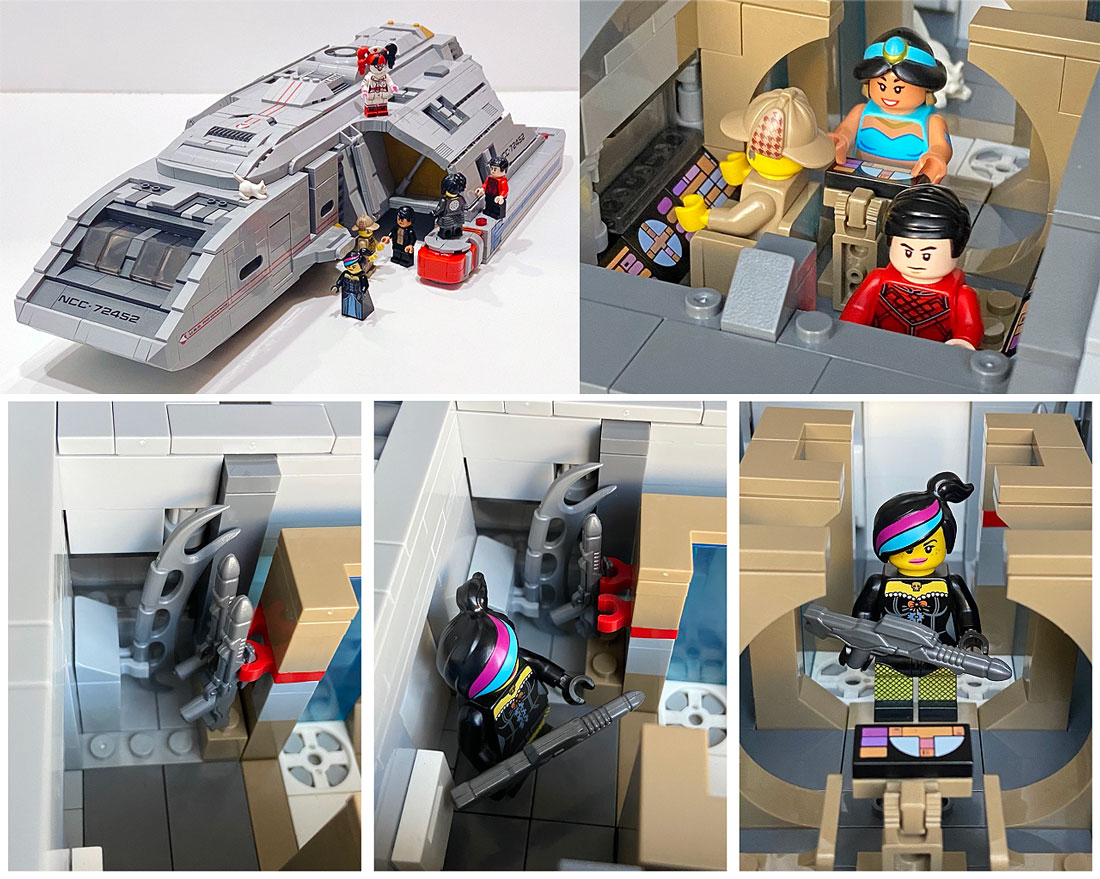
For someone who’s waited a long time for Star Trek themed LEGO sets, it’s such a joy to see Star Trek building brick sets being made by people who really care about paying homage to the franchise and doing their best to recreate some of its icons. I look forward to many more BlueBrixx sets, especially more small craft in minifig scale!
In addition to the new products BlueBrixx announced earlier this summer which are now making their way to collectors’ homes, the company also unveiled a host of new Star Trek builds at the recent Destination Star Trek Germany convention last weekend.
While their convention video is of course presented in their native German language, the new starships and other brick-build designs speak for themselves — expanding the BlueBrixx catalog from the earliest days of warp spaceflight to the far reaches of the Delta Quadrant.
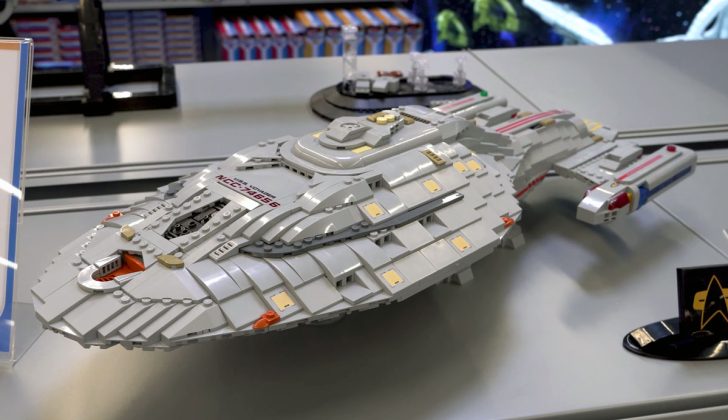
All of BlueBrixx’s available Star Trek build sets are for sale through their website, which ships internationally from their Germany distribution center. (If you’re interested in any of their newly-previewed products, you can sign up to be notified when each becomes available on that page.)
Have you bought any of BlueBrixx’s builds from their first or second wave of Star Trek releases? Do any of the new Wave 3 builds grab your attention? Let us know in the comments below!
- Trek Merchandise
Related Stories
New star trek: discovery photos — “jinaal”, star trek: discovery 502 review — “under the twin moons”, star trek: discovery premiere review — “red directive”, search news archives, new & upcoming releases, featured stories, our star trek: discovery season 5 spoiler-free review, star trek: discovery’s final adventure begins in april 2024, interview — star trek: lower decks’ mike mcmahan on moopsy, creating the orion homeworld, tuvix, and much more.
TrekCore.com is not endorsed, sponsored or affiliated with Paramount, CBS Studios, or the Star Trek franchise. All Star Trek images, trademarks and logos are owned by CBS Studios Inc. and/or Paramount. All original TrekCore.com content and the WeeklyTrek podcast (c) 2024 Trapezoid Media, LLC. · Terms & Conditions

A Comprehensive Look into ‘Star Trek: Discovery’ Season 5: Touted as the Series’ Best
Star Trek: Discovery holds an extraordinary position within the esteemed Star Trek universe. Serving as the first of its kind in various realms, from its streaming beginnings and introduction behind a paywall to showcasing a woman of color as captain. The series reinvented Star Trek’s televisual aesthetics, successfully transitioning it into the modern era characterized by cinematic visuals, high-caliber effects, and dynamic storytelling, which paved the way for newer ventures like Strange New Worlds and the anticipated Section 31 TV movie.
Though its reception has been mixed among traditional Star Trek enthusiasts, and despite not reaching profound widespread success or critical acclaim, Discovery marked a significant stride in the franchise’s evolution.
Each season of Discovery commenced with a strong start, similar to the opening act of a major film, and Season 5 was no different. Its initial episode “Red Directive” provided an enthralling space journey filled with action. Captain Michael Burnham (Sonequa Martin-Green) and company embark on an adventure following Moll (Eve Harlow) and L’ak (Elias Toufexis), who have come upon a galaxy-altering secret. However, what makes this season stand out is its brisk pace, infusion of levity, and for once, a detachment from devastating cosmic emergencies.
The introduction of Captain Rayner (Callum Keith Rennie) in Season 5 serves as a foil to Burnham’s leadership and adds an essential dynamic of professional discord and eventual harmony, adding depth to the character interactions. This season feels like a suitable finale, with characters evolving and a celebratory tone alluding to the series’ achievements, creating a peak moment that suggests this point as an ideal conclusion.
FAQ – Star Trek: Discovery Season 5
Season 5 sets itself apart with a quicker pace, a more enjoyable atmosphere devoid of immense tragic undertones that defined earlier seasons, and the arrival of a new character who contrasts with Captain Burnham, leading to interesting conflicts and developments.
Rayner, portrayed by Callum Keith Rennie, introduces a pragmatic edge and acts as a professional rival to Burnham. This dynamic enriches the narrative by introducing a character that can challenge Burnham’s command and contribute to her growth as a leader.
Yes, the production seems to indicate an awareness of its status as a finale, providing closure for character arcs and including self-referential elements that heighten the sense of a final voyage for the crew of the Discovery.
While no show can please all viewers, Season 5 of Star Trek: Discovery aims to strike a delicate balance with its pace, storytelling, and nods to Trek’s history that could appease both newcomers and seasoned fans.
Season 5 of Star Trek: Discovery triumphantly carries the torch for the franchise, pushing the boundaries of what audiences expect from a Star Trek series. With its departure from overt solemnity and the infusion of an adventurous tone akin to Indiana Jones , it presents viewers with a refreshing take on space exploration. The addition of Captain Rayner’s character adds further complexity to the relationships on board the Discovery. All these elements help establish Season 5’s unique charm that could very well make it the series’ golden moment. As the crew of the USS Discovery embarks on their final journey, fans old and new can anticipate an ending that honors the rich legacy of Star Trek while marking a pinnacle for this pioneering series.
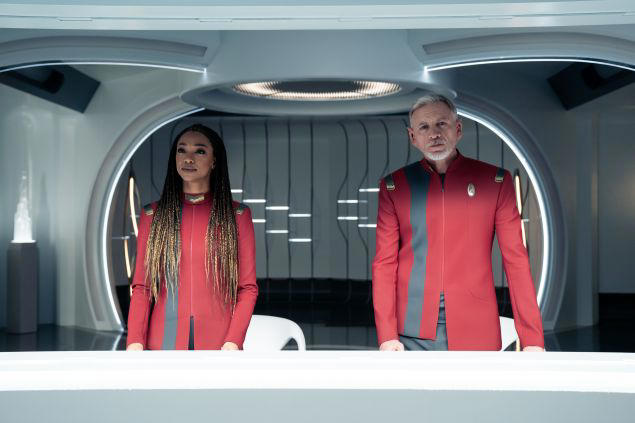
Screen Rant
Voyager is why star trek is replacing discovery’s spore drive.
Starfleet is abandoning the spore drive in Star Trek: Discovery season 5, having found a better form of warp travel thanks to the USS Voyager.
WARNING: Contains SPOILERS for Star Trek: Discovery season 5, episode 1, "Red Directive"
- Star Trek: Discovery Season 5 bids farewell to the spore drive, as USS Voyager's pathway drive takes over in the 32nd century.
- Commander Stamets reveals Starfleet's decision to halt spore drive development, making Discovery unique in the Star Trek franchise.
- The USS Voyager-J's pathway drive paves the way for safer and sustainable warp travel in Star Trek's future.
The 32nd century's version of the USS Voyager is the reason that Star Trek: Discovery season 5 is abandoning Starfleet's revolutionary spore drive technology. Since they arrived in the 32nd century in season 3, the USS Discovery crew's one-of-a-kind spore drive has represented a potential replacement for dilithium-reliant warp travel in Star Trek 's future. However, various obstacles, most notably rogue Risan scientist Ruon Tarka (Shawn Doyle) and his theft of the only working prototype, have prevented the spore drive from being rolled out.
In Star Trek: Discovery season 5, episode 1 , "Red Directive", Commander Paul Stamets (Anthony Rapp) reveals that Starfleet has shuttered further development on the spore drive . Starfleet's decision means that the USS Discovery will remain one-of-a-kind, making season 5 the last outing for Starfleet's spore drive. Instead of taking Discovery's spore drive further, Starfleet are instead forging ahead with the new pathway drive, first trialled by the USS Voyager-J in Star Trek: Discovery season 4 .
Star Trek Is Ditching Discovery's Spore Drive - And That's Good!
Uss voyager is why star trek is quitting discovery’s spore drive, voyager has a history of scientific advancement in starfleet..
In Star Trek: Discovery 's season 4 premiere, "Kobayashi Maru", it was revealed that the USS Voyager-J had been newly fitted with a protoype pathway drive . President Laira Rillak (Chelah Horsdal) was looking for the right captain to command the ship and test out this new technology. Now, Discovery 's season 5 premiere, "Red Directive" reveals that those tests were successful, leading to the pathway drive being the new standard for future Starfleet ships. The rollout is still in the early stages, however, as Captain Rayner (Callum Keith Rennie) states that his ship, the USS Antares, doesn't have a pathway drive fitted.
Captain Michael Burnham (Sonequa Martin-Green) was under consideration to command the USS Voyager-J, but President Rillak didn't believe that she was ready.
It feels appropriate that the USS Voyager is responsible for replacing Star Trek: Discovery 's spore drive, given its namesake's impact on warp travel centuries earlier . Star Trek: Prodigy revealed that, after returning to the Alpha Quadrant, much of the technology the USS Voyager encountered in the Delta Quadrant was adapted by Starfleet. For example, the USS Dauntless, commanded by Vice Admiral Kathryn Janeway (Kate Mulgrew) had a quantum slipstream drive fitted, first encountered in Star Trek: Voyager 's season 4 finale, "Hope and Fear" .
Why Star Trek Keeping Standard Warp Travel Is Best
The specifics of how the pathway drive works are still a mystery in Star Trek: Discovery season 5, but it's presumably rooted in traditional warp travel. The spore drive was an incredibly complicated method of travel that required specific calculations and a willing host to navigate the mycelial network . In "Red Directive", Stamets states that, with more time, he could have worked out the issues with navigation, but never got the chance. The grisly fate of the USS Glenn in Discovery season 1 revealed that the slightest miscalculation in spore drive navigation could have devastating consequences for the crew.
Presumably, the pathway drive is a means to achieve warp travel while using less dilithium, to reduce the Federation's reliance on it following the scarcity caused by the Burn. This is therefore a less risky proposition, which will be why Starfleet are now rolling it out following the USS Voyager-J's successful trial. While it may be disappointing for Stamets in Star Trek: Discovery , the pathway drive's potential to make warp travel safer and more sustainable should be something to celebrate.
Star Trek: Discovery streams Thursdays on Paramount+.
Star Trek: Prodigy season 1 is streaming on Netflix.
Star Trek: Discovery
*Availability in US
Not available
Star Trek: Discovery is an entry in the legendary Sci-Fi franchise, set ten years before the original Star Trek series events. The show centers around Commander Michael Burnham, assigned to the USS Discovery, where the crew attempts to prevent a Klingon war while traveling through the vast reaches of space.
Star Trek Voyager
The fifth entry in the Star Trek franchise, Star Trek: Voyager, is a sci-fi series that sees the crew of the USS Voyager on a long journey back to their home after finding themselves stranded at the far ends of the Milky Way Galaxy. Led by Captain Kathryn Janeway, the series follows the crew as they embark through truly uncharted areas of space, with new species, friends, foes, and mysteries to solve as they wrestle with the politics of a crew in a situation they've never faced before.
Star Trek: Prodigy
Star Trek: Prodigy is the first TV series in the Star Trek franchise marketed toward children, and one of the few animated series in the franchise. The story follows a group of young aliens who find a stolen Starfleet ship and use it to escape from the Tars Lamora prison colony where they are all held captive. Working together with the help of a holographic Captain Kathryn Janeway (Kate Mulgrew), the new crew of the USS Protostar must find their way back to the Alpha Quadrant to warn the Federation of the deadly threat that is pursuing them.
Why ‘Star Trek: Discovery’ Built Season 5 Around a Classic Episode From a Legacy Series
By Adam B. Vary
Adam B. Vary
Senior Entertainment Writer
- Why ‘Star Trek: Discovery’ Built Season 5 Around a Classic Episode From a Legacy Series 5 days ago
- ‘Star Trek: Discovery’ Star Sonequa Martin-Green on the Show’s Unexpected Final Season, the ‘Pressure’ of Representation and Taking the ‘Trek’ Cruise 6 days ago
- Jerrod Carmichael Was Terrified of Being Seen, So He Made a Reality Show: ‘This May Be Unhealthy. It Is a Little Dangerous’ 2 weeks ago

SPOILER ALERT: This story discusses major plot developments in Season 5, Episode 1 of “ Star Trek : Discovery,” now streaming on Paramount+.
By the end of the episode, however, the mission has pushed Burnham and her crew to their limits, including slamming the USS Discovery into the path of a massive landslide threatening a nearby city. Before they risk their lives any further pursuing this object, Burnham demands that Kovich at least tell her why. (MAJOR SPOILERS FOLLOW.)
Kovich’s explanation evokes the classic “ Star Trek: The Next Generation ” episode “The Chase” from 1993 in which Capt. Jean-Luc Picard (Patrick Stewart) — along with teams of Romulans, Klingons and Cardassians — learn that all humanoid life in the galaxy was created by a single species that existed billions of years earlier, and seeded thousands of planets with the DNA to pass along their legacy. (Along with presenting a profound vision of the origins of life, the episode also provided an imaginative explanation for why almost all the aliens in “Star Trek” basically look like humans with different kinds of forehead ridges.)
Kovich tells Burnham that the Romulan scientist was part of a team sent to discover exactly how these aliens — whom they call the Progenitors — made this happen; the object they’re seeking winds up being one part of a brand new “chase,” this time in the 32nd century, to find the Progenitors’ technology before it can fall into the wrong hands.
“I remember watching that episode and at the end of it just being blown away that there was this huge idea where we all come from,” Paradise says. “And then they’re going to have another mission the next week. I found myself wondering, ‘Well, then what? What happened? What do we do with this information? What does it mean?’”
Originally, Paradise says the “Discovery” writers’ room discussed evoking the Progenitors in Season 4, when the Discovery meets an alien species, the 10-C, who live outside of the galaxy and are as radically different from humans as one could imagine. “As we dug deeper into the season itself, we realized that it was too much to try and get in,” Paradise says.
Instead, they made the Progenitors the engine for Season 5. “Burnham and some of our other characters are on this quest for personal meaning,” Paradise says. Searching for the origins of life itself, she adds, “feels like a big thematic idea that fits right in with what we’re exploring over the course of the season, and what our characters are going through.”
That meant that Paradise finally got to help come up with the answers to the questions about “The Chase” that had preoccupied her when she was younger. “We had a lot of fun talking about what might’ve happened when [Picard] called back to headquarters and had to say, ‘Here’s what happened today,’” she says. “We just built the story out from there.”
More From Our Brands
Larry david tried so hard to avoid all emotion on the last day of filming ‘curb your enthusiasm’, rolex’s 2023 daytona lemans was just discontinued, nwsl’s red stars move bay fc match to wrigley field, the best loofahs and body scrubbers, according to dermatologists, kat dennings to play tim allen’s daughter in abc comedy pilot, verify it's you, please log in.

USS Orinoco
- View history
The USS Orinoco was a 24th century Federation Danube -class runabout operated by Starfleet . This ship, a replacement for USS Yangtzee Kiang , was assigned to Deep Space 9 . It was outfitted with a sensor pod during most of its missions.
- 2.1 Appearances
- 2.2 Background information
- 2.3 Apocrypha
- 2.4 External link
History [ ]
In 2370 , the Orinoco was assigned to Deep Space 9 , meant as a replacement for the previously destroyed USS Yangtzee Kiang . It was used to evacuate the station of all non- Bajoran personnel. ( DS9 : " The Siege ")
During a plasma disruption that forced the evacuation of DS9, the Orinoco was at Landing Pad C in case the skeleton crew had to leave in a hurry. Later, Verad planned to use the runabout to make his escape. ( DS9 : " Invasive Procedures ")
Lieutenant Jadzia Dax and Ensign Melora Pazlar used the Orinoco to travel to the Gamma Quadrant where they conducted a survey of an unknown sector of space. The runabout was later hijacked by Fallit Kot , but Melora was able to subdue him by deactivating the artificial gravity . ( DS9 : " Melora ")
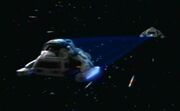
The Rio Grande tows the Orinoco
Shortly after stardate 47573.1, Major Kira Nerys and Jadzia used the Orinoco to track down the USS Rio Grande , which had been reported traveling at warp 2 , unpiloted, in Sector 401 . When the Orinoco caught up with the Rio Grande , Dax used an old " Hopi rope-trick" with the Orinoco 's tractor beam to force the Rio Grande out of warp . The Orinoco was later towed back to the Orellius system by the Rio Grande . ( DS9 : " Paradise ")
Later, on stardate 47603.3, Jadzia and Odo used the Orinoco to investigate a particle field in the Gamma Quadrant. They later detected omicron particles from Rurigan 's hologenerator . ( DS9 : " Shadowplay ")
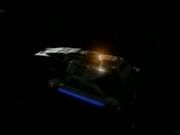
The Orinoco after its sensor pod was severed
Later that year, the Orinoco , the Rio Grande , and the USS Mekong held a defensive position meant to prevent the Maquis from attacking Bryma , a Cardassian colony in the Demilitarized Zone . Kira and Dax piloted the Orinoco during the blockade. The Orinoco was attacked by one of the Maquis ships , which sheared off its navigational array with phasers. Chief O'Brien , aboard the Mekong , later assisted in the repairs of the Orinoco . ( DS9 : " The Maquis, Part II ")
In late 2370, Chief O'Brien outfitted the Orinoco with extra banks of photon torpedoes . It was piloted by Kira and Doctor Julian Bashir while it assisted the USS Odyssey during its rescue attempt of Commander Benjamin Sisko , who was being held prisoner by the Dominion in the Gamma Quadrant. During the ensuing battle, the Orinoco helped lay down covering fire for the nearly-disabled Mekong , and later attempted to intercept the kamikaze Jem'Hadar attack ship that destroyed the Odyssey . ( DS9 : " The Jem'Hadar ")
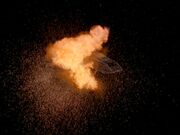
The Orinoco 's destruction
The Orinoco was destroyed by the Cardassian terrorist group the True Way in 2372 . The True Way had sabotaged the vessel by removing the warp core ejection system . Sisko, Kira, Worf, Dax and O'Brien were transported off the runabout in time. ( DS9 : " Our Man Bashir ")
Appendices [ ]
Appearances [ ].
- " Invasive Procedures "
- " Paradise "
- " Shadowplay "
- " The Maquis, Part II "
- " The Jem'Hadar "
- " Our Man Bashir "
Background information [ ]
The Star Trek Encyclopedia (4th ed., vol. 2, p. 112) listed this runabout with registry number NCC -72905. The reference work stated that the Orinoco was named after the Orinoco river which, with a length of 2,410 kilometers, was one of the largest rivers of South America.
In a draft of " In the Hands of the Prophets ", O'Brien looks for evidence that someone has tampered with the Orinoco with the intent of stealing it at a later time. ( The Making of Star Trek: Deep Space Nine )
In an article in Billboard in June 1994, an article writer speculated that the Orinoco might have also been named after Orinoco Flow , a song by Enya: " According to those who should know, Enya may remain on the chart well into the 24th century. One of the runabouts on "Star Trek: Deep Space Nine" is named the Orinoco . Yes, it's after the river, but surely the writers were inspired by Enya's first Hot 100 single, 'Orinoco Flow (Sail Away)'" . [1]
In 1994, Playmates Toys issued a toy runabout Orinoco along with their line of Star Trek: Deep Space Nine action figures. The Star Trek: The Official Starships Collection released the Orinoco as the Danube -class model of the magazine.
Apocrypha [ ]
The Orinoco was featured at the start of Star Trek: Deep Space Nine - Harbinger .
External link [ ]
- USS Orinoco (NCC-72905) at Memory Beta , the wiki for licensed Star Trek works
- 2 Reaction control thruster
- More to Explore
- Series & Movies
Published Apr 2, 2024
What to Expect from The Final Season of Star Trek: Discovery
The cast details everything you need to know to get ready for the Season 5 premiere this week!

Getty Images / StarTrek.com
The highly anticipated fifth and final season of Star Trek: Discovery arrives this week!
This season finds Captain Burnham and the crew of the U.S.S. Discovery uncovering a mystery that will send them on an epic adventure across the galaxy to find an ancient power whose very existence has been deliberately hidden for centuries. But there are others on the hunt as well… dangerous foes who are desperate to claim the prize for themselves and will stop at nothing to get it.
Ahead of the premiere, StarTrek.com had the opportunity to speak with series cast Sonequa Martin-Green (Captain Michael Burnham), Doug Jones (Saru), Anthony Rapp (Paul Stamets), Mary Wiseman (Sylvia Tilly), Wilson Cruz (Dr. Hugh Culber), David Ajala (Cleveland "Book" Booker), Blu del Barrio (Adira), along with this season's recurring guest star Eve Harlow (Moll) and executive producer and co-showrunner Michelle Paradise . With their help, here's what you can expect from their characters this season!
In case you need a quick refresher before we dive forward, we've got a handy Where We Left Off guide !
Now let's fly!
Sonequa Martin-Green on Season 5 Stakes and Captain Michael Burnham's Relationship Status

"Red Directive"
StarTrek.com
"This season, we can expect a wild ride," teases Sonequa Martin-Green. "One of the things that they wanted to do was that they wanted to have a tonal shift. They wanted it to be adventurous, they wanted it to be fun, they wanted it to be kind of like the Indiana Jones season. And so we really did that. We really did that. The artistry is on another level."
"In every department, you will see some really incredible things coming to life," continues Martin-Green. "In Season 5, we did some stuff we should not have been able to do; we did some stuff that we've never done before. I'm really proud of every department, of every cast member, of every crew member, every writer, every producer, every post-production coordinator, and supervisor, and worker. We took it to the next level without even knowing that it was our last season. When everyone sees it, I think that they'll see what I'm talking about. It's culminating because of that; it is just on another level. It's a huge, huge season. People have a lot to look forward to."
Addressing where Michael Burnham and Book find themselves at the start of this season, Martin-Green explains, "Book and Burnham, they are the classic, old Facebook status of 'It's complicated.' They've got a lot to work through. That's where we pick up with them, having not been speaking as regularly as they normally do. Of course, we see that he was sent off at the end of Season 4. Now they are back in each other's midst, and they have got a lot to talk about and a lot to wade through. It's very complicated between them. There's obviously still that love, that deep love, that bond, that respect, but they've got a lot to work through."
Doug Jones on Saru's Next Step
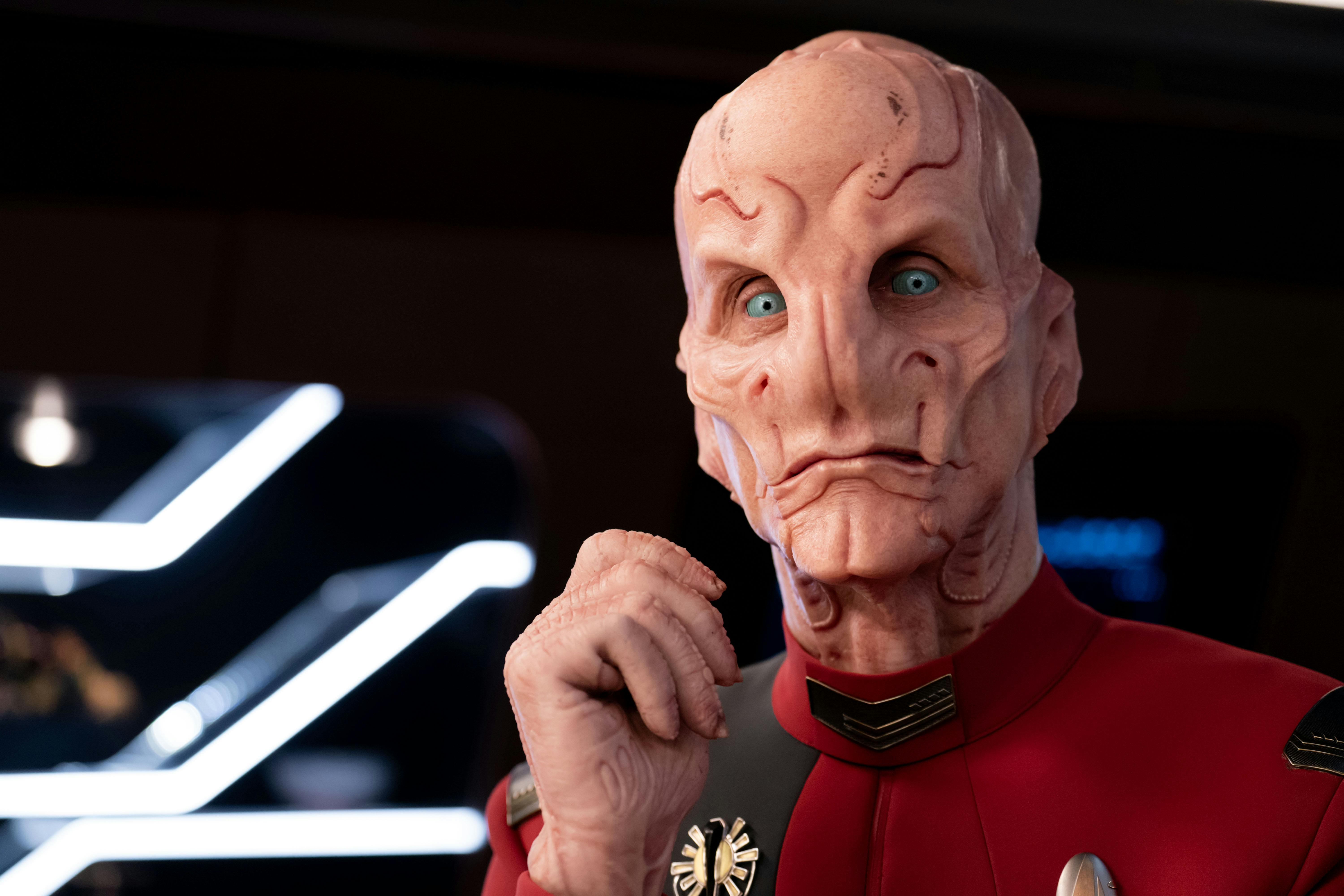
"Under the Twin Moons"
Reflecting on Saru's journey across the entire series, Doug Jones reveals, "Saru had been captain of the ship for Season 3. And Season 4, he then kind of took a step to First Officer again, because of his loyalty to Michael Burnham, and the special task we were on throughout the season."
"Well, now he’s [re-evaluating] his purpose there," adds Jones. "Has it run its course? His relationship with President T’Rina, played by the lovely Tara Rosling. She does come into the equation with how he makes his decision."
Anthony Rapp on Paul Stamets' Legacy and Season 5 Baddies
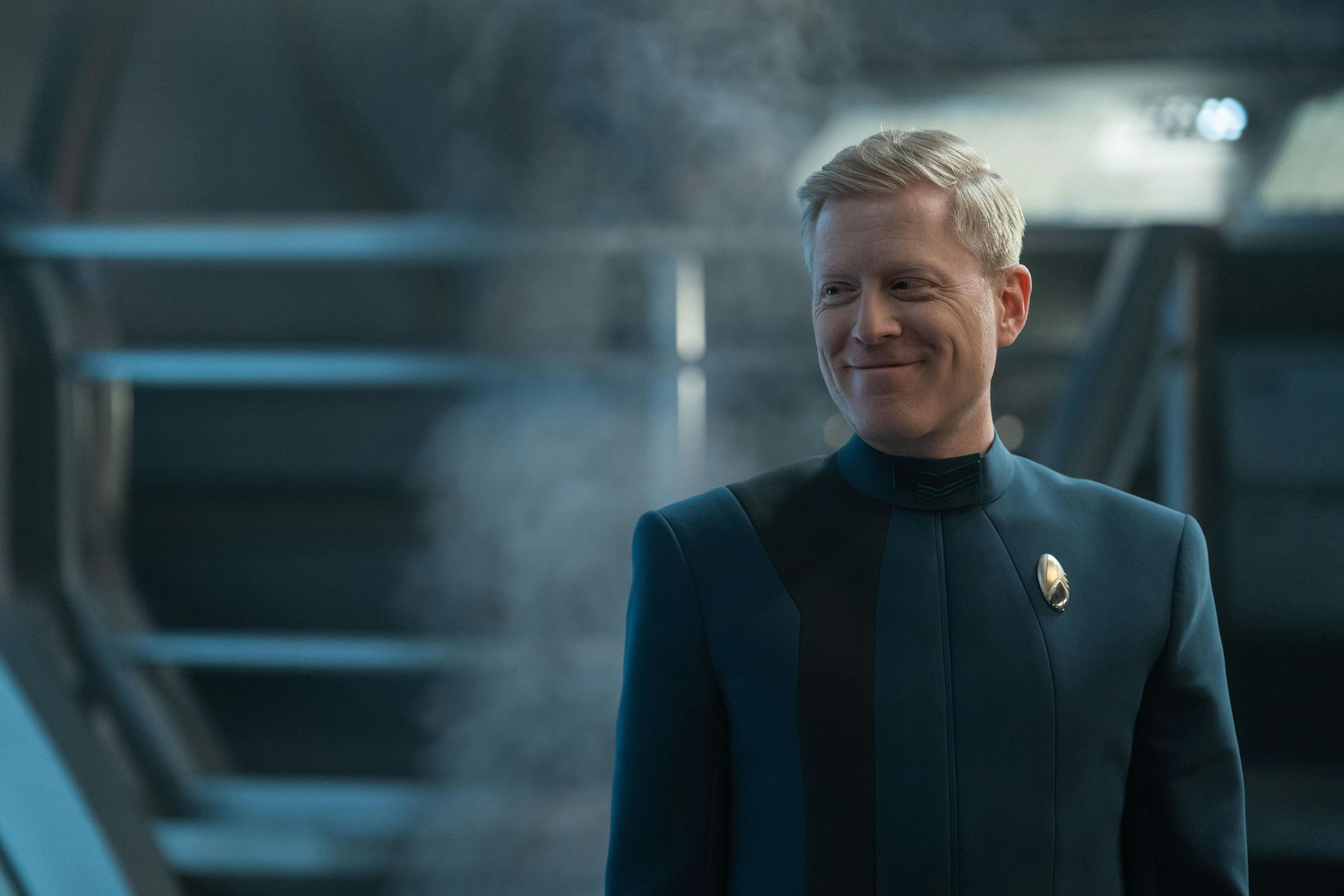
Episode 506
"This season, you can expect a new level of inquiry for Paul about what's next for him in terms of the work that he wants to do," hints Anthony Rapp. "He's an incredibly driven and brilliant human being with this mind, that's some level of genius. You get to see him like stretch himself in new ways."
What does the Discovery crew make of arrival of this season's antagonists — Moll (played by Eve Harlow) and L'ak (played by Elias Toufexis)?
"I really love the description of this kind of Bonnie and Clyde," shares Rapp. "It was fun for us, or for me, I could speak for myself, to have these kind of iconic touchstone archetypes brought into our show. Their energy as people; [Eve Harlow and Elias Toufexis] brought a beautiful energy to the company to being a part of our show and being a part of our story. And then their work was exceptional. To have this, this idea of this kind of like maverick couple that's on the run is a cool one. And there's a reason it's iconic. And I think that the way that our writers threaded it through our story was really well done."
Mary Wiseman on Sylvia Tilly's Career Focus
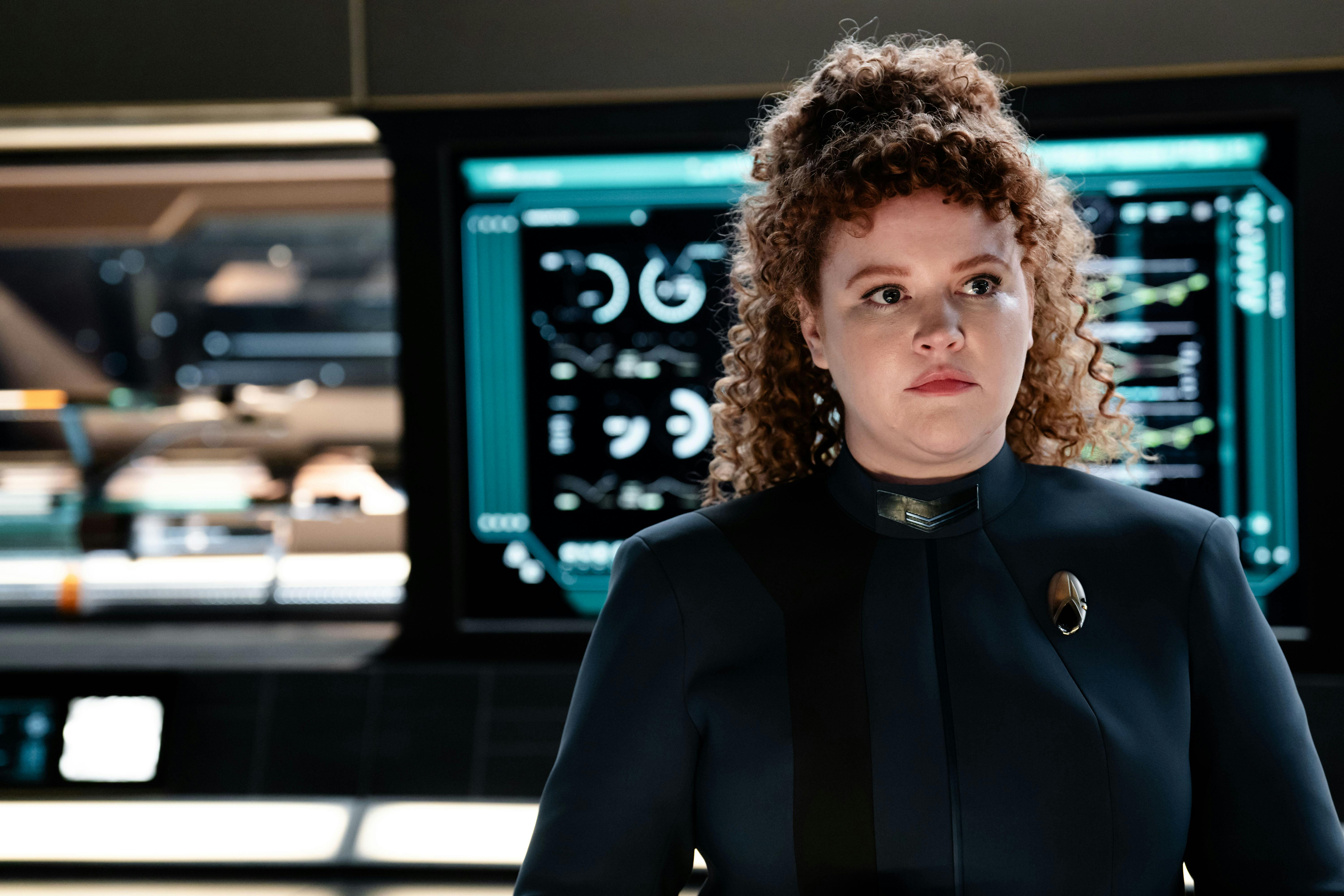
"Tilly's in a great place," notes Mary Wiseman. "She's found a certain kind of assurance from going off to teach at Starfleet Academy, and coming back feels like coming home. You're a little cooler and a little more adult. And people call you 'Miss.'"
However, that's not without some challenges. "But she kind of also feels stuck with the problem about how to get through to these kids that have grown up in this era where there isn't the sort of interconnectedness, galaxy-wide communication, and transportation possibilities that there were when she was growing up," highlights Wiseman. "And she's kind of noticing it in the kids' behavior, and inability to interact or team build. And so that's something that she kind of wants to work on and figure out how to help them out with that."
Wilson Cruz on Dr. Hugh Culber's New Experiences
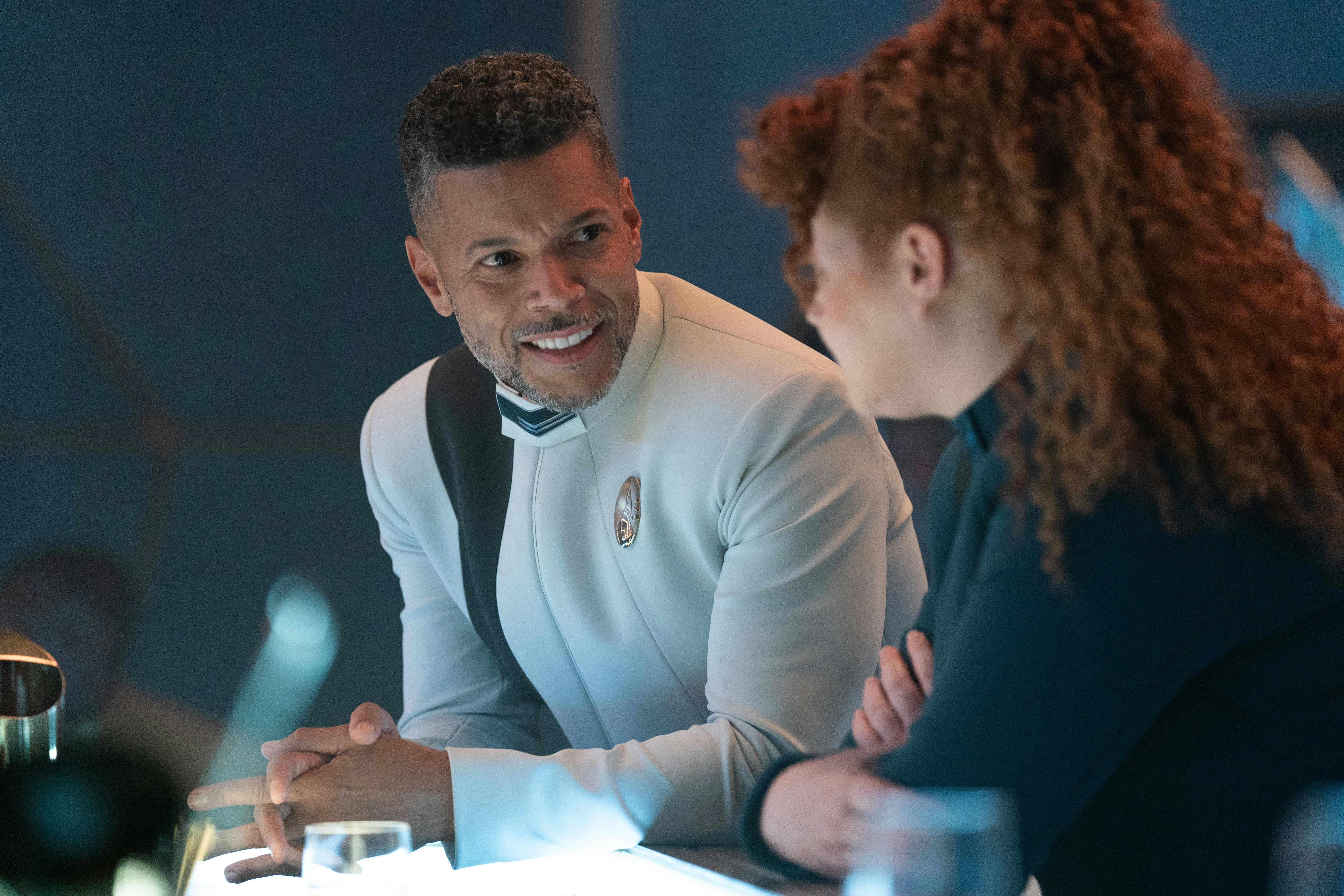
Episode 505
"Where we first find Culber in Season 5, he's in a really good place," notes Wilson Cruz. "He's really embodied this new version of himself, and is ready and willing to take on whatever he's confronted with."
Cruz continues, "This season, he is confronted with an experience that forces him to ask even more existential questions that kind of blows his mind. It starts him on knowing about all of the mysteries of the universe. This whole mission really makes him question a lot of things. We see him process a lot of that throughout the season."
David Ajala on Cleveland "Book" Booker's Love for Burnham and Season 5 Action Sequences
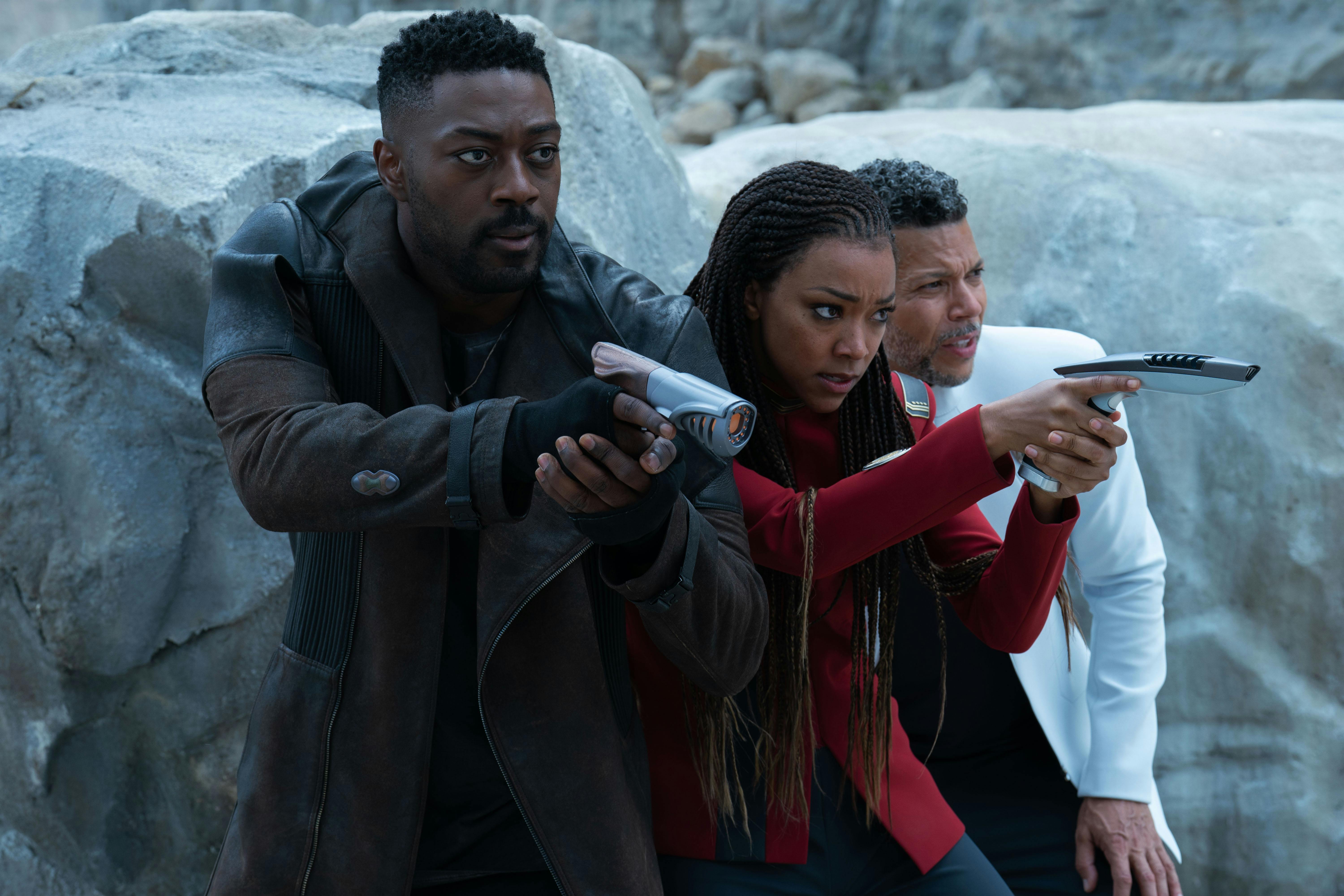
Episode 503
Following the events of Season 4, Book must walk away from Burnham. Reflecting on his actions and headspace at the start of this season, David Ajala states, "It's interesting, because, if we're talking about the gift of grace, Book has definitely received grace from Michael Burnham. Even though Book made the decision that he thought was right, it was not even honorable, but he felt duty bound to do what he did. He was still afforded grace by Michael Burnham, to be welcomed back with open arms. The journey of someone like Cleveland Booker, who was very driven by keeping his autonomy, and also serving his purpose on the planet, which was to help endangered species, to be a part of Starfleet, it was never something that was within his remit. But then to come full circle in Season 5, and to see him, organically incorporate himself within that team is a wonderful story."
"Where we left off in Season 4, revisiting and coming back for Season 5, it's a different territory for both of them," explains Ajala. "And yet, they both have to acknowledge that they're in different spaces, but then still show a level of care for one another. This grey area is new territory."
As for the Indiana Jones -level of excitement the series explores this season, Ajala details, "I love action, I love being able to be physical, to express myself. Having said that, I love the way action is used in the right way. And because this is the final season, we could have taken like one to potentially three episodes to kind of warm into it. But with the first episode, we were straight in with high octane, big action sequences, and just a real spectacle to observe."
Blu del Barrio on Adira's Growing Confidence
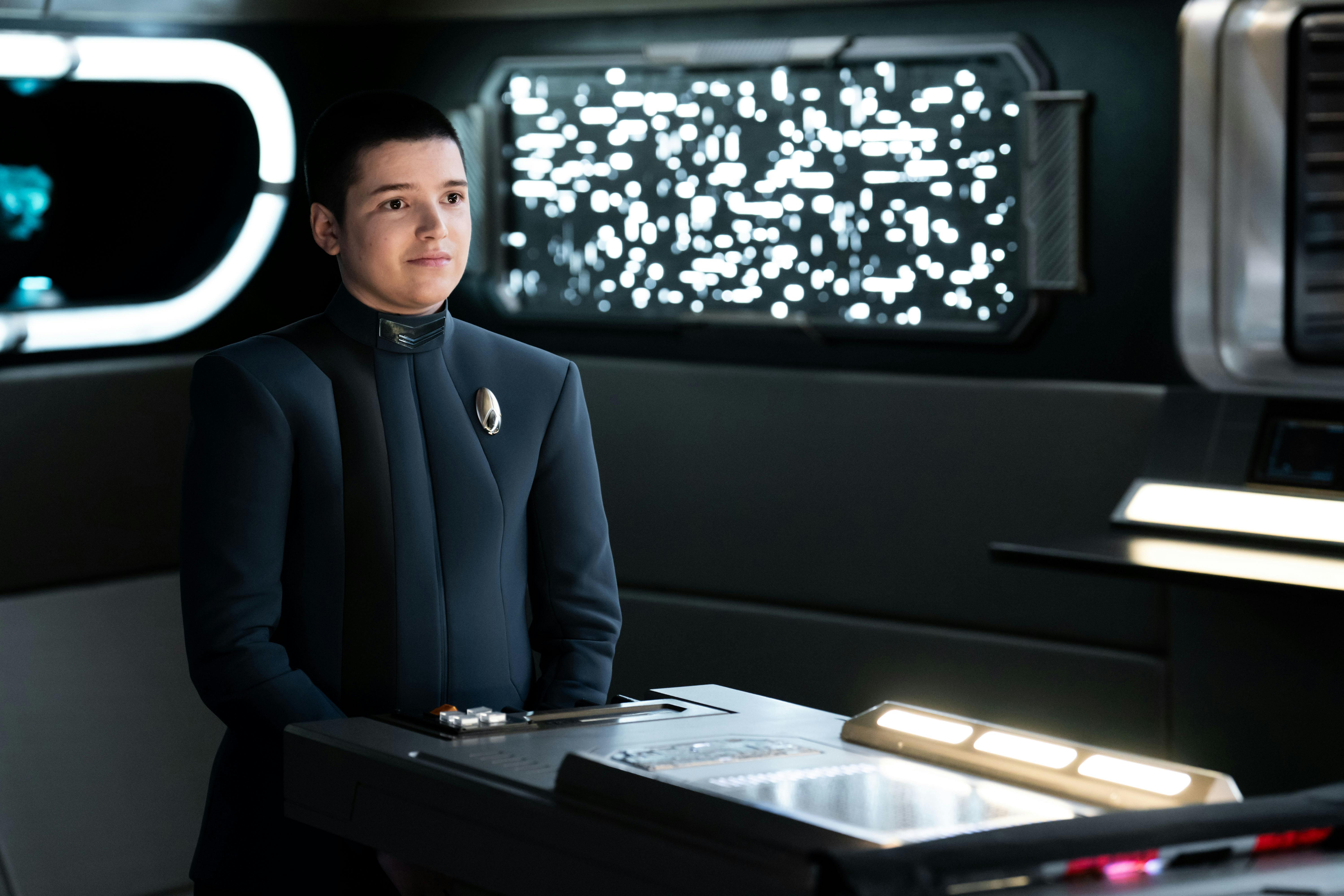
"Adira starts out in a pretty solid looking place," reveals Blu del Barrio.
"On the outside, they look and seem really good," adds del Barrio. "They have a lot more responsibilities on the ship. And they're taking their work very seriously, and just very happy to be like more integrated. But underneath the surface, they're struggling a little bit more with some emotional stuff and some major personal stuff."
Eve Harlow on the Arrival of Star-Crossed Lovers and Joining the Cast of Discovery
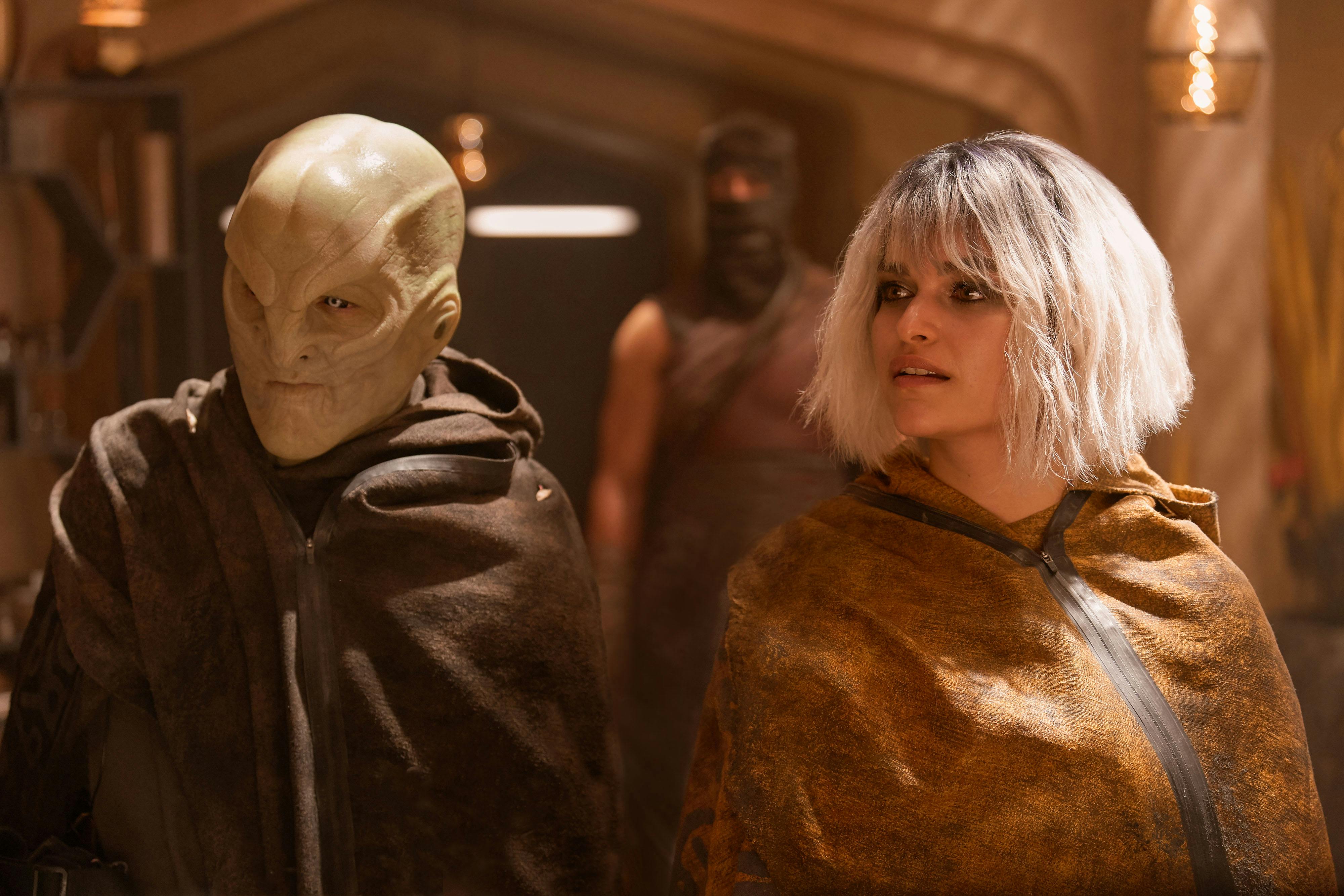
During NYCC 2022 , audiences got to learn about this season's baddies. Moll and L'ak are former couriers turned outlaws. Moll is highly intelligent and dangerous, with an impressive strategic mind and a sharp wit. She goes into every situation with a clear plan and stays focused and clear-headed on her goal, even when things go awry. She’s not easy to intimidate, and will face down anyone who stands in her way in order to get what she wants. Whereas L'ak is tough, impulsive, and fiercely protective of his beloved partner, Moll. So long as he knows she’s safe, he doesn’t care about collateral damage or its consequences — a perspective that makes him very dangerous at times and will put him on the opposite side of Captain Burnham and the crew of the U.S.S. Discovery when they come into conflict.
Speaking directly to StarTrek.com on Star Trek: The Cruise VII, Eve Harlow divulges, "Moll is badass, and she and L’ak are an interspecies couple. It’s kind of breaking all the rules, which is why they’re on the run. It’s very much like Romeo and Juliet or Bonnie and Clyde because they’re star-crossed lovers."
On her experience of joining this series for its fifth season, Harlow offers tons of praises, "These are some of the kindest, just most welcoming people I've ever met. I feel like I just talk about how much I love Sonequa a lot, but I will keep talking about how much I love her. She is the best leader I've ever experienced on set."
"[When I reflected on] who on-set is most like their character in real life. Without skipping a beat, Elias and I, at the same time, were Sonequa. She is that captain, and she treats everyone like an equal. I've just never been on a set where everyone, the crew is so appreciated. She knows everybody's names. She knows what they do. She knows their family life, what's going on with them. She genuinely cares, and being around that, that spirit is infectious. Every single time I was on set. I was so high energy; I was just so happy to be here. And it's because of the people who were working on that show."
Michelle Paradise on Season 5's New Faces
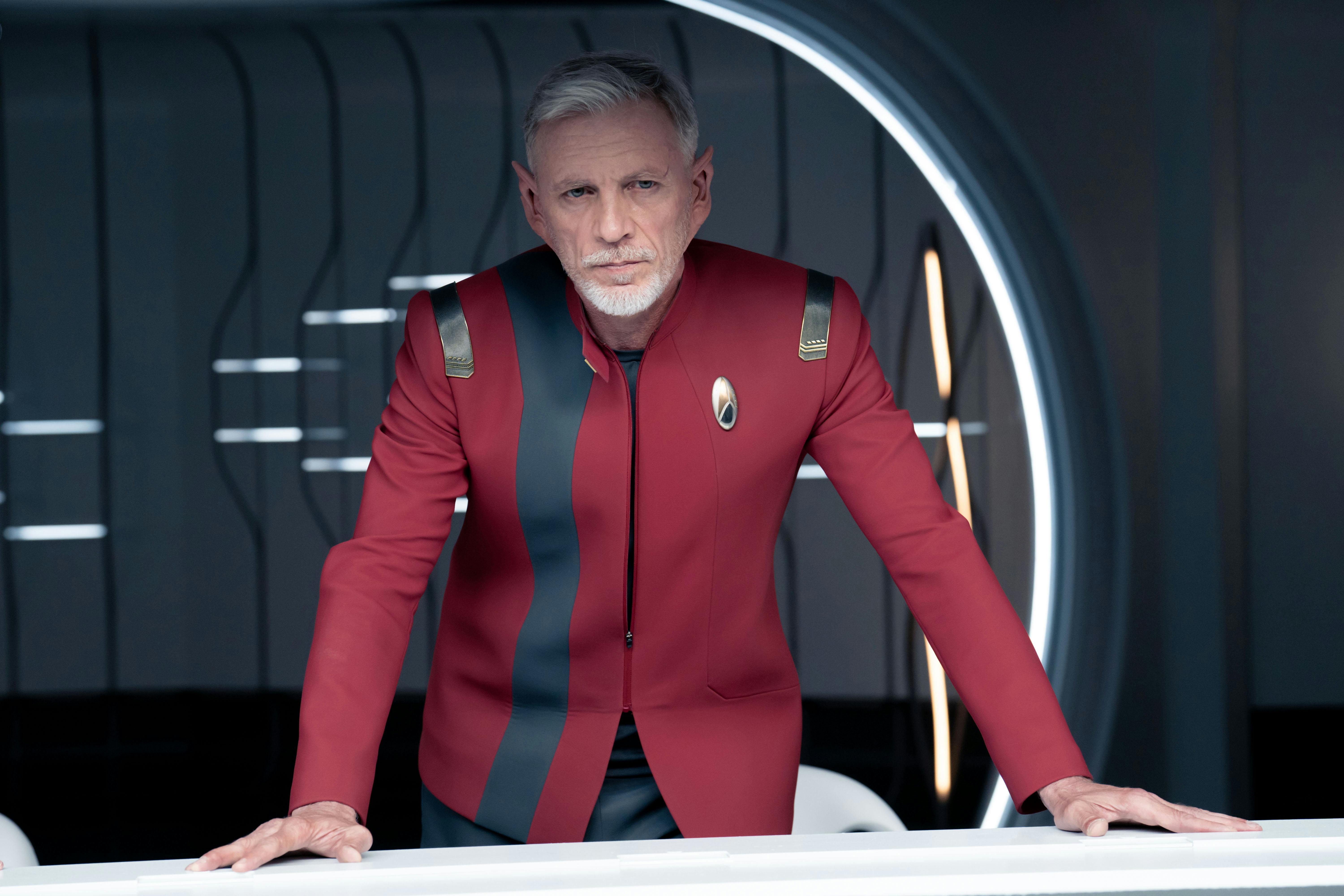
"Elias [Toufexis] and Eve [Harlow] play L’ak and Moll who are our two new bad guys this season," states Michelle Paradise. "We talked about them as kind of a Bonnie and Clyde unit. We hadn't had a couple before as our antagonist. In turn, they're obviously formidable foes for our heroes. But we also really wanted to make sure that they felt well-rounded, and that they weren't just one note, bad guys. We understood the why of what they were doing the depth of their love for one another. People will be surprised that they may start rooting for these bad guys, actually. But they'll never want them to win more than our heroes, of course. It’s a lot of fun to have them."
L'ak and Moll aren't the only new faces this season. Rayner, also previously announced at NYCC 2022, is a gruff, smart Starfleet captain who holds a clear line between commander and crew — he leads, they follow. Rayner’s all about the mission, whatever it may be, and he doesn’t do niceties along the way; his feeling is, you get the job done and apologize later. He has a storied track record of wartime success, but in times of peace, he struggles. Collaboration is not his strong suit. That said, if it serves the greater good he’s willing to learn... but it won’t be easy.
"And then Callum Keith Rennie plays Captain Rayner," elaborates Paradise. "What's interesting about him is that he is going to be a bit of an antagonist, but not in a bad guy way. He's going to push Burnham, and we'll get to see new sides of Burnham and new growth in Burnham because of her interactions with him. It's a really interesting dynamic there. That's one of the things that we always look at, if we're going to bring in any new guest characters, is how can they impact our regulars? And how can they help our regulars grow over the course of the season or change or help us see new sides of them, and these three do that beautifully."
Get ready for Discovery 's final adventure when Season 5 premieres with the first two episodes later this week!
Get updates by email.
Christine Dinh (she/her) is the managing editor for StarTrek.com. She’s traded the Multiverse for helming this Federation Starship.
Star Trek: Discovery Seasons 1 through 4 are streaming exclusively on Paramount+ in the U.S., the UK, Switzerland, South Korea, Latin America, Germany, France, Italy, Australia and Austria. Seasons 2 and 3 also are available on the Pluto TV “Star Trek” channel in Switzerland, Germany and Austria. The series streams on Super Drama in Japan, TVNZ in New Zealand, and SkyShowtime in Spain, Portugal, Poland, The Nordics, The Netherlands, and Central and Eastern Europe. In Canada, the series airs on Bell Media’s CTV Sci-Fi Channel. Star Trek: Discovery is distributed by Paramount Global Content Distribution.


IMAGES
VIDEO
COMMENTS
Star Trek. ) Runabouts (" Danube-class " vessels) are a fictional class of small, multi-purpose starships appearing in the Star Trek science-fiction franchise, primarily the television series Star Trek: Deep Space Nine, which aired on syndicated television between 1993 and 1999. They served as a means of transport for the crew of the fictional ...
In Federation starship classification, a runabout was the designation of a type of vessel smaller than a starship but larger than a shuttlecraft. Runabouts were equipped with limited weapons and drive systems, but offered additional living space and the ability to be configured to mission-specific cargo capacities. They had a larger operational range and better weapons capability compared to ...
The Danube-class, also known as Runabout-class, was a type of Federation runabout in operation during the latter half of the 24th century. All runabouts assigned to Deep Space 9 were named after rivers on Earth. (DS9: "Family Business") The Danube-class was first commissioned by Starfleet in 2368 as a small, short-range interstellar craft. (DS9: "Paradise") The following year, the space ...
This is the story of a little ship that took a little trip: DS9's runabout.Read the article here: https://whatculture.com/tv/star-trek-10-secrets-of-the-danu...
The Micro Machines runabout model was marked as the Rio Grande, as was the AMT/Ertl model kit (on the packaging, at least, as the builder could name the model Rio Grande, Ganges, or Yangtzee Kiang) and the Furuta kit. Apocrypha [] The Rio Grande was still in service in the year 2385, at the time of the Star Trek: The Fall novel A Ceremony of ...
It was a 3D computer model of the "Runabout" shuttle for Star Trek: The Next Generation. Previously, Star Trek had exclusively used physical models, which at the time were composited by Adam Howard and Steve Scott at Digital Magic. VisionArt's 3D model of the Runabout was primarily used for the stretching effect when it jumped to warp.
Learn how the Danube-class runabout, a small and versatile ship that appeared in Deep Space Nine and other Star Trek series, was designed and built from an existing studio model. Find out how the runabout's cockpit was modified from the Executive Shuttle and what features made it unique and iconic.
The Danube Class Runabout is the principle vehicle with which the crew of Deep Space Nine explore space, before the arrival of the USS Defiant. These small s...
Very special thank you to Captain Meatshield for his metal rendition of the DS9 theme music. Check out his channel: https://www.youtube.com/c/CaptainMeatshie...
Star Trek The Official Starships Collection has released images and details of its next two issues. Issue #32 is a Starfleet Runabout and Issue #33 is a Cardassian Hideki class. Larger than regular shuttlecraft, the Danube-class Runabout was an essential component of 24th-century Starfleet space stations.
The runabout, including its flight deck set, also appeared in TNG: "Timescape" and in VOY: "Non Sequitur". In addition, the interior was slightly redressed three times to act as Chakotay's ship, as vessels of the Mirror Universe and as the "Insurrection" shuttlecraft. ... Star Trek: Insurrection Star Trek: Insurrection (as Enterprise-E shuttle)
For other uses, see Runabout. A runabout was a small warp-capable vessel, similar to a shuttlecraft, but providing for more interior space and crew amenities for extended interstellar trips. The Hubble VXT was a type of runabout in Starfleet service in the mid-23rd century. (TOS novel: Final Frontier) The Federation Starfleet Danube-class of starships were referred to as runabouts. (DS9 ...
Star Trek: 10 Secrets Of The Danube-class Runabout. 6. Starship Side Piece. Going all the way back to the impressive 1:1 scale Galileo built for Star Trek: The Original Series, full-size ...
Introduced in the Star Trek: Deep Space Nine pilot episode "Emissary," as the station's primary support craft, the Danube-class runabout has joined now joined the ranks of Eaglemoss/Hero Collector's line of XL Starship models.. Designed to be more durable and versatile craft than the shuttles that preceded them, the runabout was originally designed by Rick Sternbach and Jim Martin ...
Sci-fi. Star Trek. In an alternate timeline, the Yellowstone-class runabout was an upgraded design of the Danube-class runabout designed in the late-24th century. The Yellowstone-class was designed for a variety of mission profiles. The prototype vessel of this class was the USS Yellowstone, which was designed by...
Early scripts for Star Trek: Deep Space Nine referred to the three runabouts docked at the station as "Runabout-class" vessels. However, this designation was never spoken on screen and Michael and ...
Developed in the late 2380s, the Arrow class runabout is a much larger craft than the Danube class runabout, at around twice its length. It is intended for longer duration missions and can support larger crews. Unlike its smaller cousin, it is less modular; interior spaces can be reconfigured for mission needs, but it is more complicated than simply swapping different modules, so typically ...
A runabout was a spacecraft type introduced by Starfleet in the late 2360s. Runabouts were warp-capable vessels between a shuttle and a starship in size, and capable of being operated by one crew member, although two or more was preferred. They featured expanded cargo and passenger capability over shuttles. Runabouts were armed well enough to defend themselves against similarly sized attackers ...
Warp is faster-than-light, so the implication is that a runabout isn't. It would just have impulse engines. Although it's reasonable that these definitions are flexible. In DS9 the runabouts have warp engines. Could be the meanings overlap, and a shuttle is just something on a ship while a runabout is for a station.
It was the only runabout of the original trio to survive the full run of the Star Trek: Deep Space Nine series. Over the course of the series, the Rio Grande discovered the Bajoran wormhole, crossed over into the Mirror Universe, and even singlehandedly destroyed a Jem'Hadar attack ship.
It seems whenever we hear mention of a runabout assigned to DS9 it's named after a river on Earth—the Rio Grande, the Ganges, ... While Star Trek's producers generally preferred not to use exclusively Earth-centric names and references (generally following the rule that if there are three proper names, two can be from Earth but one must be ...
Conclusion. Season 5 of Star Trek: Discovery triumphantly carries the torch for the franchise, pushing the boundaries of what audiences expect from a Star Trek series. With its departure from ...
The USS Ganges (NCC-72454) was a 24th century Federation Danube-class runabout operated by Starfleet. The ship was assigned to Deep Space 9. In 2369, the Ganges was one of three runabouts delivered to the new starbase Deep Space 9 by the starship USS Enterprise-D. (DS9: "Emissary") The Ganges was outfitted with a rollbar containing sensor equipment when it assisted in the apprehension of ...
The USS Voyager-J's pathway drive paves the way for safer and sustainable warp travel in Star Trek's future. The 32nd century's version of the USS Voyager is the reason that Star Trek: Discovery season 5 is abandoning Starfleet's revolutionary spore drive technology. Since they arrived in the 32nd century in season 3, the USS Discovery crew's ...
Latest; Why 'Star Trek: Discovery' Built Season 5 Around a Classic Episode From a Legacy Series 3 days ago 'Star Trek: Discovery' Star Sonequa Martin-Green on the Show's Unexpected Final ...
Background information []. The Star Trek Encyclopedia (4th ed., vol. 2, p. 112) listed this runabout with registry number NCC-72905.The reference work stated that the Orinoco was named after the Orinoco river which, with a length of 2,410 kilometers, was one of the largest rivers of South America.. In a draft of "In the Hands of the Prophets", O'Brien looks for evidence that someone has ...
The highly anticipated fifth and final season of Star Trek: Discovery arrives this week!. This season finds Captain Burnham and the crew of the U.S.S. Discovery uncovering a mystery that will send them on an epic adventure across the galaxy to find an ancient power whose very existence has been deliberately hidden for centuries.But there are others on the hunt as well… dangerous foes who are ...